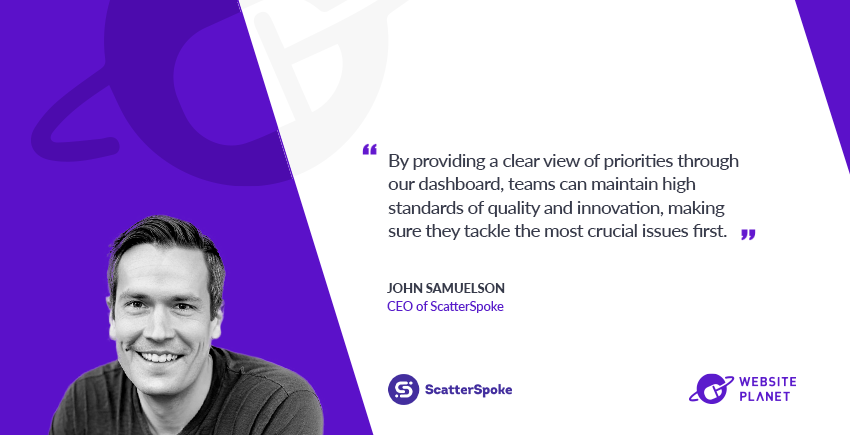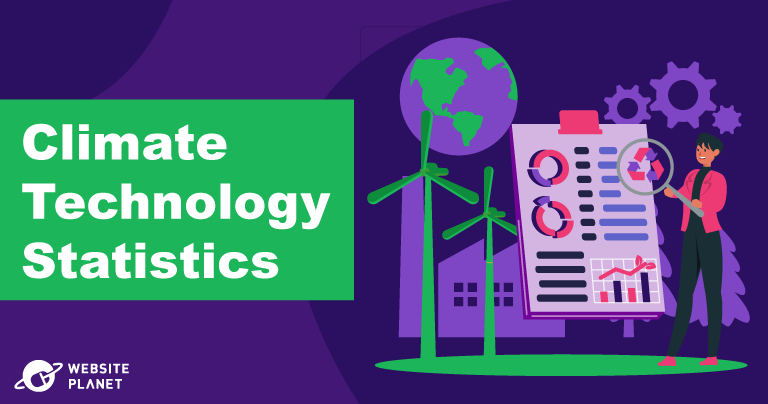Inside this Article
The History of Blogging
The history of blogging? Does blogging have a history? Well, believe it or not, blogging has been around in some form or another for a long time, and it’s racked up a few memorable dates since its beginnings. So, before we launch head-first into the world of blogging statistics, let’s take a look at the origins of the practice that has taken the internet by storm.1. The First Blog
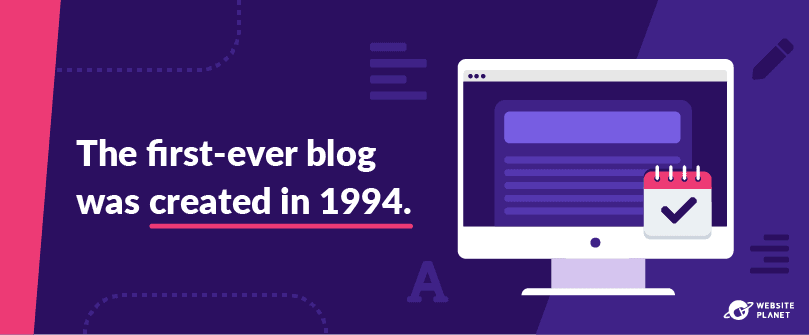 That’s right; the first-ever blog was created over 25 years ago.
You’ve got a man named “Justin Hall” to thank for today’s blogging phenomenon. While studying at Swarthmore College in Pennsylvania, Justin started a blog site called “Justin’s Links from the Underground.”
I say blog — the term did not exist in 1994. Rather, Justin’s Links started by offering a virtual tour of the internet. The domain soon developed into a collection of light-hearted musings that provided insight into the everyday life of Justin.
We now recognize this as a blog, a form that gathered serious momentum in the years following Justin’s creation.
That’s right; the first-ever blog was created over 25 years ago.
You’ve got a man named “Justin Hall” to thank for today’s blogging phenomenon. While studying at Swarthmore College in Pennsylvania, Justin started a blog site called “Justin’s Links from the Underground.”
I say blog — the term did not exist in 1994. Rather, Justin’s Links started by offering a virtual tour of the internet. The domain soon developed into a collection of light-hearted musings that provided insight into the everyday life of Justin.
We now recognize this as a blog, a form that gathered serious momentum in the years following Justin’s creation.
2. Where Did “Blog” Come From?
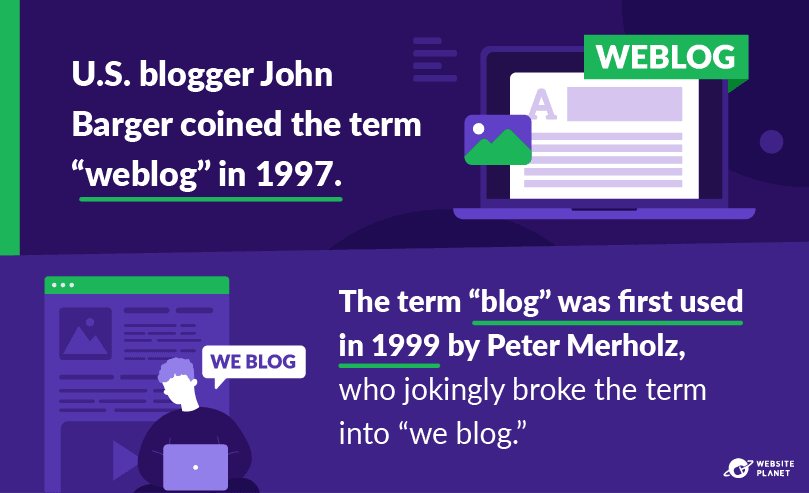 We take the term “blog” for granted nowadays, but it wasn’t always common knowledge. Internet users referred to blogs as “personal pages” or “online diaries” before 1997, which is a little bit long-winded…
Enter stage-left John Barger, whose term “weblog” seemingly makes sense, but blog? Where did that come from?
Well, it was sort of a joke. Peter Merholz used the term in the sidebar of his blog site, peterme.com, to describe that he does indeed write a blog. We-blog… get it?
Okay, so it’s not laugh-out-loud hilarious, but the term has undoubtedly caught on since. You’ve got Peter to thank for that.
We take the term “blog” for granted nowadays, but it wasn’t always common knowledge. Internet users referred to blogs as “personal pages” or “online diaries” before 1997, which is a little bit long-winded…
Enter stage-left John Barger, whose term “weblog” seemingly makes sense, but blog? Where did that come from?
Well, it was sort of a joke. Peter Merholz used the term in the sidebar of his blog site, peterme.com, to describe that he does indeed write a blog. We-blog… get it?
Okay, so it’s not laugh-out-loud hilarious, but the term has undoubtedly caught on since. You’ve got Peter to thank for that.
3. The First Journalist Blogs
 1998 was somewhat of a momentous year for blogging. Before Jonathan Dube, the blogging landscape was dominated by programmers writing about technical subjects. These were the only people with enough knowledge to design and build websites.
Jonathan’s introduction showed that you don’t have to be a programmer to write a blog post. And that blogs can cover a range of issues, niches, and topics — including news-worthy subjects.
1998 was somewhat of a momentous year for blogging. Before Jonathan Dube, the blogging landscape was dominated by programmers writing about technical subjects. These were the only people with enough knowledge to design and build websites.
Jonathan’s introduction showed that you don’t have to be a programmer to write a blog post. And that blogs can cover a range of issues, niches, and topics — including news-worthy subjects.
4. A Community Approach
 Against a backdrop of burgeoning online social connectivity, Open Diary launched, bringing a community approach to blogging that we know (and love) today.
Open Diary allowed users to comment on other peoples’ blog posts. Its introduction signaled the first of many blogging tools that made the practice accessible to everyone, not just programmers.
Against a backdrop of burgeoning online social connectivity, Open Diary launched, bringing a community approach to blogging that we know (and love) today.
Open Diary allowed users to comment on other peoples’ blog posts. Its introduction signaled the first of many blogging tools that made the practice accessible to everyone, not just programmers.
5. Blogging Hit the Big Time
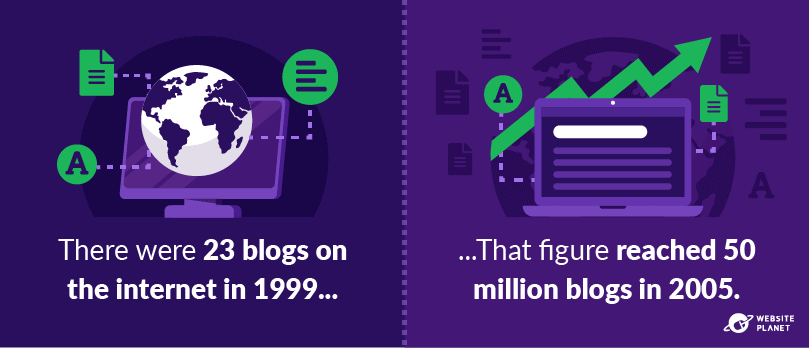 The blogging landscape changed forever in 1999, a year that introduced important blogging sites like LiveJournal, Blogger, and Xanga.
LiveJournal started as a place its owner, Brad Fitzpatrick, could maintain contact with his school friends. The site soon grew into a community where users could record their thoughts and network with like-minded people.
Other notable blogging tools include Technorati, a search engine for blogs, and Audio Blogger, the world’s first podcasting service.
The greater accessibility provided by these tools led to a massive jump in the number of blogs — there were 50 million of them by 2005.
The blogging landscape changed forever in 1999, a year that introduced important blogging sites like LiveJournal, Blogger, and Xanga.
LiveJournal started as a place its owner, Brad Fitzpatrick, could maintain contact with his school friends. The site soon grew into a community where users could record their thoughts and network with like-minded people.
Other notable blogging tools include Technorati, a search engine for blogs, and Audio Blogger, the world’s first podcasting service.
The greater accessibility provided by these tools led to a massive jump in the number of blogs — there were 50 million of them by 2005.
6. AdSense Launched
 AdSense has been the major player in blog monetization and ad management over the last 2 decades. AdSense launched in 2003, along with a few other notable players. Namely WordPress and TypePad.
Liveblogging was up-and-running in 2003, too. The form is now common for event writers and news sites.
AdSense has been the major player in blog monetization and ad management over the last 2 decades. AdSense launched in 2003, along with a few other notable players. Namely WordPress and TypePad.
Liveblogging was up-and-running in 2003, too. The form is now common for event writers and news sites.
7. The Most Profitable Blog Of All Time
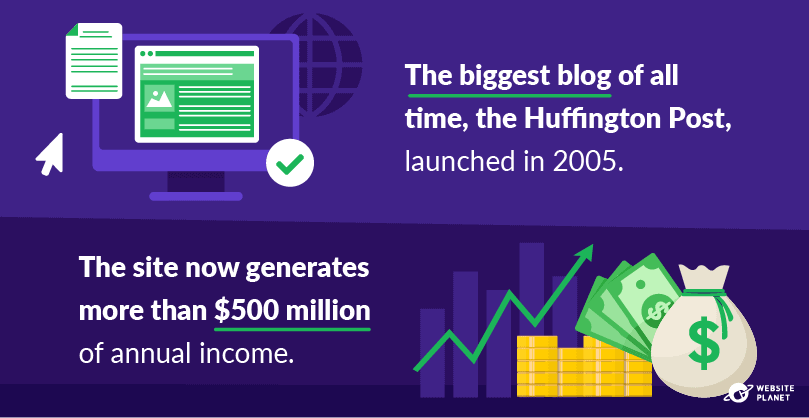 2005 saw the rise of the Huffington Post, the internet’s biggest blogging sensation. As both a blog site and a news site, the Huffington Post blurred the lines between news reporting and the world wide web.
We’ve seen a significant rise in news-centric blog sites ever since, and who can blame them?
The Huffington Post is a freakishly successful blog site. The site’s sizable turnover demonstrates the popularity and financial prosperity that an excellent blog site can enjoy.
2005 saw the rise of the Huffington Post, the internet’s biggest blogging sensation. As both a blog site and a news site, the Huffington Post blurred the lines between news reporting and the world wide web.
We’ve seen a significant rise in news-centric blog sites ever since, and who can blame them?
The Huffington Post is a freakishly successful blog site. The site’s sizable turnover demonstrates the popularity and financial prosperity that an excellent blog site can enjoy.
Blogging Industry Overview
Now you’ve got a good idea about the origins of blogging, we’ll look at some general blogging statistics in 2021. How many blogs are there? Who reads blogs? And why are they important?8. How Many Blogs Are There?
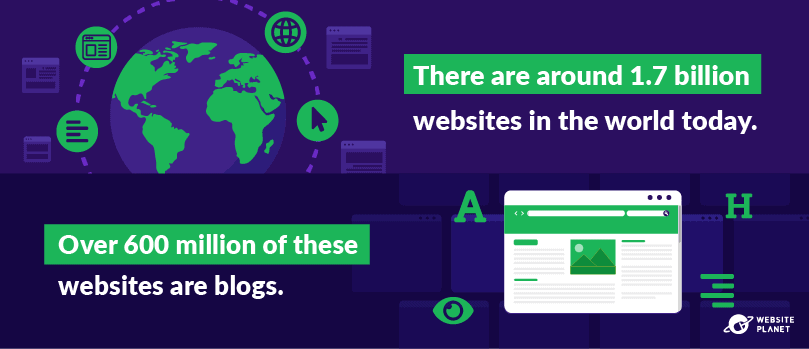 Blogging is extremely popular in 2021. Marketers, experts, and hobbyists use blogging for several reasons; people may blog because they want to grow an audience, teach others about a particular subject, have fun, or boost performance for their brand.
600 million blog sites publish 7 million blog posts every day. That’s 4,800 posts every minute, or 2.5 billion posts a year!
Blogging is extremely popular in 2021. Marketers, experts, and hobbyists use blogging for several reasons; people may blog because they want to grow an audience, teach others about a particular subject, have fun, or boost performance for their brand.
600 million blog sites publish 7 million blog posts every day. That’s 4,800 posts every minute, or 2.5 billion posts a year!
9. How Many People Read Blogs?
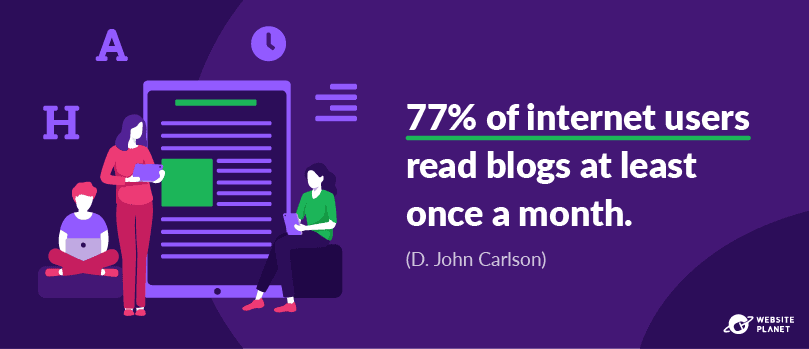 Pretty much all of us read blog posts, even if we don’t realize it. Blog posts make up the bulk of article content online, and they’re a great way to learn about a particular subject or become invested in a particular story.
Roughly 80% of internet users read blogs. Online blogs can consist of product reviews, comparisons, listicles, diary-style entries, and so much more!
WordPress is one of the most popular website builders for bloggers. On this site alone, 409 million people rack up 20 billion page views every month.
Pretty much all of us read blog posts, even if we don’t realize it. Blog posts make up the bulk of article content online, and they’re a great way to learn about a particular subject or become invested in a particular story.
Roughly 80% of internet users read blogs. Online blogs can consist of product reviews, comparisons, listicles, diary-style entries, and so much more!
WordPress is one of the most popular website builders for bloggers. On this site alone, 409 million people rack up 20 billion page views every month.
10. How Many Bloggers Are There?
 The popularity of blogging is growing, and fast. There are 31.7 million bloggers in America, and this figure has risen from 27.4 million in the last few years.
That means around one-tenth of the American population is blogging. In fact, America is the most popular blogging nation in the world, accounting for nearly 30% of all bloggers.
The popularity of blogging is growing, and fast. There are 31.7 million bloggers in America, and this figure has risen from 27.4 million in the last few years.
That means around one-tenth of the American population is blogging. In fact, America is the most popular blogging nation in the world, accounting for nearly 30% of all bloggers.
*11. Blogs Get Results
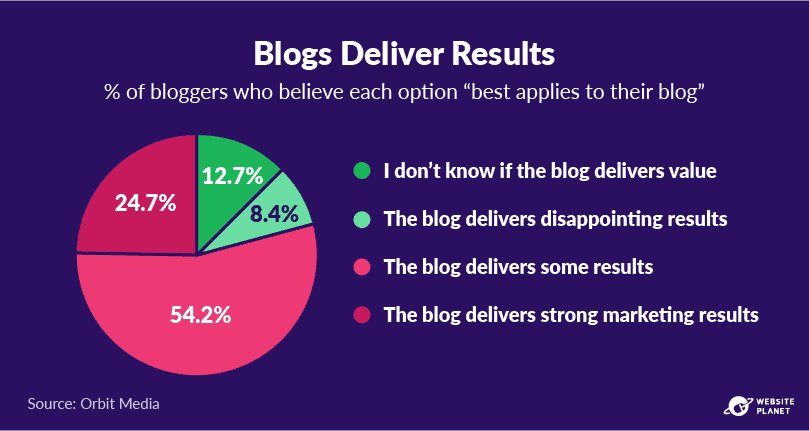 Blogging delivers results. In one study, nearly 80% of bloggers reported results from their blogging efforts. 24.7% of bloggers said they achieved “strong results” with their blog.
Out of everyone included in the survey, just 8.4% of bloggers said they were disappointed with the results they were getting from their blog.
The survey points to the effectiveness of blogging and highlights that results can mean many different things for different bloggers.
For a casual blogger, results could mean teaching a ton of readers about a certain topic and getting great feedback. Alternatively, marketers may measure success through sales metrics like leads and conversions.
Blogging helps you achieve all of these effects and more! That’s why so many different bloggers find value in their content.
Blogging delivers results. In one study, nearly 80% of bloggers reported results from their blogging efforts. 24.7% of bloggers said they achieved “strong results” with their blog.
Out of everyone included in the survey, just 8.4% of bloggers said they were disappointed with the results they were getting from their blog.
The survey points to the effectiveness of blogging and highlights that results can mean many different things for different bloggers.
For a casual blogger, results could mean teaching a ton of readers about a certain topic and getting great feedback. Alternatively, marketers may measure success through sales metrics like leads and conversions.
Blogging helps you achieve all of these effects and more! That’s why so many different bloggers find value in their content.
12. Average Blog Length?
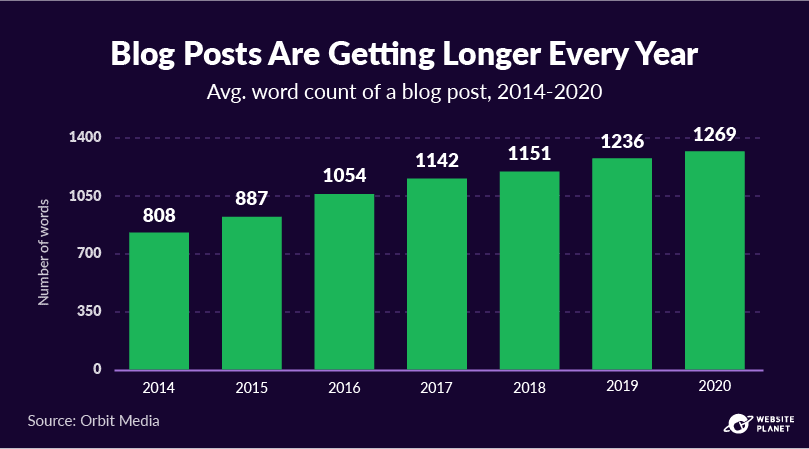 The average blog post is getting longer every year. The average blog post was just 808 words long in 2014. In 2020, the average blog post was 1269 words long.
Why are bloggers turning to more long-form content? With a longer piece, writers can provide more information (and more value) to the viewer.
Though, there is still some contention as to what content length performs best. By all accounts, writers produce shorter blogs faster, but longer posts deliver on a range of other performance indicators.
The average blog post is getting longer every year. The average blog post was just 808 words long in 2014. In 2020, the average blog post was 1269 words long.
Why are bloggers turning to more long-form content? With a longer piece, writers can provide more information (and more value) to the viewer.
Though, there is still some contention as to what content length performs best. By all accounts, writers produce shorter blogs faster, but longer posts deliver on a range of other performance indicators.
13. Blog Reader Age Demographics
 How old are blog readers? Most blog readers are aged between 31 and 40, according to research from 99firms.
The next most popular age range is 41-50, accounting for 23.1% of blog readers, while 16.8% are aged between 25 and 30.
This is a little bit surprising. 50% of active internet users are 34 or below, so we expect to see greater representation from young adults in the blog reader study.
However, many blog readers are experienced marketers or professionals within a given field. People who are looking to network, gather information, and discover new products for their business — these people are often slightly older.
How old are blog readers? Most blog readers are aged between 31 and 40, according to research from 99firms.
The next most popular age range is 41-50, accounting for 23.1% of blog readers, while 16.8% are aged between 25 and 30.
This is a little bit surprising. 50% of active internet users are 34 or below, so we expect to see greater representation from young adults in the blog reader study.
However, many blog readers are experienced marketers or professionals within a given field. People who are looking to network, gather information, and discover new products for their business — these people are often slightly older.
14. Boomers Aren’t Always Sold on Blogs
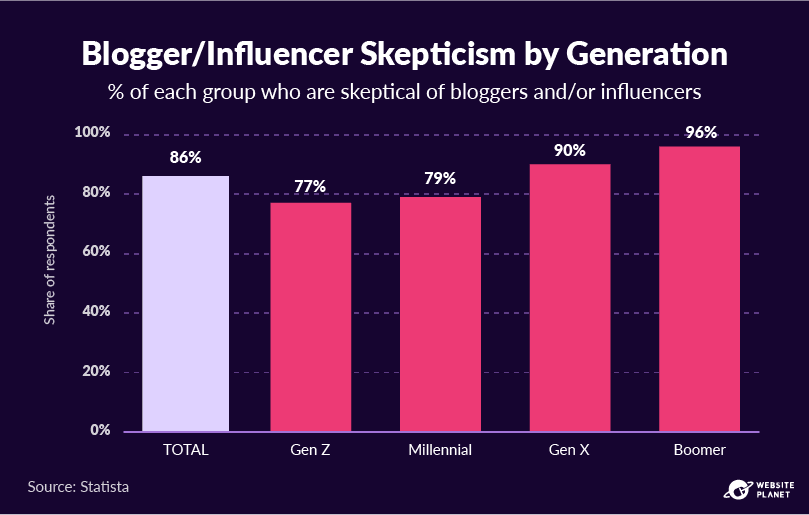 It’s bizarre that, while baby boomers make up a significant portion of blog readers, a large percentage of them are skeptical of what internet personalities have to say.
Some 96% of boomers demonstrate some level of skepticism about online influencers or bloggers. However, we must consider that the above study also references “influencers” in its question, so the respondents may have been reacting to that term and not to blogging itself.
Still, the results show that blogging can be quite a divisive thing. While some people trust content, others are skeptical of the source.
Skeptics should read more great, informative blog posts. That will surely change their mind!
It’s bizarre that, while baby boomers make up a significant portion of blog readers, a large percentage of them are skeptical of what internet personalities have to say.
Some 96% of boomers demonstrate some level of skepticism about online influencers or bloggers. However, we must consider that the above study also references “influencers” in its question, so the respondents may have been reacting to that term and not to blogging itself.
Still, the results show that blogging can be quite a divisive thing. While some people trust content, others are skeptical of the source.
Skeptics should read more great, informative blog posts. That will surely change their mind!
15. The Adblock Generation
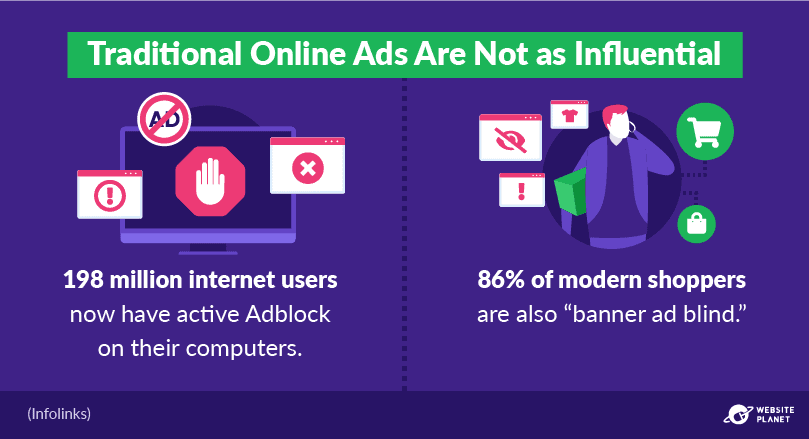 Online ads don’t have the same impact as they did a few years ago. Why? Adblock.
Adblock is one key reason blog content is so important, whether you’re blogging for marketing purposes or a particular niche.
The number of people using Adblock reduces the effectiveness of traditional marketing advertisements. It can also cut some of the monetization profits for niche bloggers.
Fortunately, blogging offers a solution to both of these issues. Marketers can use blogs to build awareness and interest around their brand without producing expensive (and ineffective) adverts.
For niche bloggers, affiliate marketing offers a bountiful source of alternative income. Bloggers can promote other services or products and see tangible results.
Online ads don’t have the same impact as they did a few years ago. Why? Adblock.
Adblock is one key reason blog content is so important, whether you’re blogging for marketing purposes or a particular niche.
The number of people using Adblock reduces the effectiveness of traditional marketing advertisements. It can also cut some of the monetization profits for niche bloggers.
Fortunately, blogging offers a solution to both of these issues. Marketers can use blogs to build awareness and interest around their brand without producing expensive (and ineffective) adverts.
For niche bloggers, affiliate marketing offers a bountiful source of alternative income. Bloggers can promote other services or products and see tangible results.
Business Blogging & Impacts
In section 3, we’ll look at some blogging stats relevant to the world of business and marketing. Some of these effects are not exclusive to brands that blog. Blogging can boost a site’s credibility, backlinks, indexed pages, and traffic. These effects are not only great for businesses. They’re useful for niche or personal blogs too. That being said, 95% of professional bloggers sell a product or service on their site (ConvertKit). Blogging can impact leads, ROI, and sales apply to anyone who aims to make it big in the blogging world.16. Customers Need Blogs
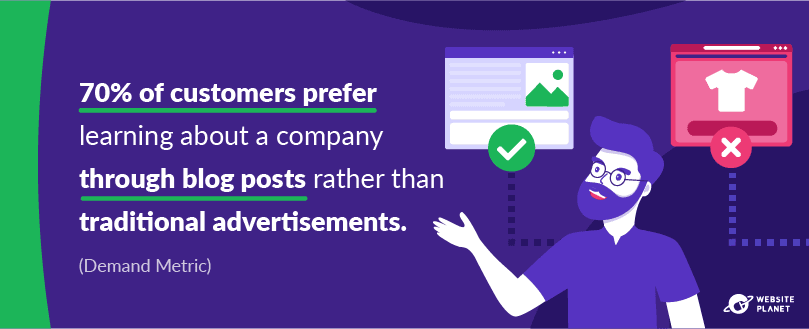 Customers need blogs. Blogs provide essential information that they need to know before purchasing something.
81% of consumers in a GE survey said they typically research a product online before buying. Therefore, catering to this requirement is extremely important for B2C businesses — it could make the difference between a sale or a snub.
Blogging even helps B2C companies capture business from competitors. A customer may come to a B2C blog to read up on a particular type of product, only for the business’ knowledge and expertise to wow them into a purchase.
It’s these factors that make blogging an essential practice; 60% of marketers believe content marketing is either “very” or “extremely” important to their marketing strategy (HubSpot).
Customers need blogs. Blogs provide essential information that they need to know before purchasing something.
81% of consumers in a GE survey said they typically research a product online before buying. Therefore, catering to this requirement is extremely important for B2C businesses — it could make the difference between a sale or a snub.
Blogging even helps B2C companies capture business from competitors. A customer may come to a B2C blog to read up on a particular type of product, only for the business’ knowledge and expertise to wow them into a purchase.
It’s these factors that make blogging an essential practice; 60% of marketers believe content marketing is either “very” or “extremely” important to their marketing strategy (HubSpot).
17. B2B Clients Value Blogs
 Blogging is crucial for B2B marketers. Arguably, blogging is even more critical in the B2B sector than in the B2C sector. 93% of B2B content marketers blog, as opposed to 83% of B2C content marketers (CMI).
Blogging is still one of the top content choices for both sectors, but in B2B, blog content is truly one of the best ways to drum up meaningful leads for a business.
B2B buyers need a ton of information before they purchase. They’re not just buying a pair of shoes or a laptop; B2B purchases are large-scale orders that could affect the fortunes of a client’s enterprise.
It’s for this reason that B2B buyers consume several blog posts before considering a purchase. It’s also why 57% of B2B marketers have obtained new customers through blogging (SEO Tribunal).
Blogging is crucial for B2B marketers. Arguably, blogging is even more critical in the B2B sector than in the B2C sector. 93% of B2B content marketers blog, as opposed to 83% of B2C content marketers (CMI).
Blogging is still one of the top content choices for both sectors, but in B2B, blog content is truly one of the best ways to drum up meaningful leads for a business.
B2B buyers need a ton of information before they purchase. They’re not just buying a pair of shoes or a laptop; B2B purchases are large-scale orders that could affect the fortunes of a client’s enterprise.
It’s for this reason that B2B buyers consume several blog posts before considering a purchase. It’s also why 57% of B2B marketers have obtained new customers through blogging (SEO Tribunal).
18. Marketers Love Blog Posts
 No matter the study, blogging consistently ranks as one of the most utilized and appreciated forms of content for marketers.
Short-form blogs are the top content type for B2B and B2C marketers in CMI’s study. In HubSpot’s survey, marketers used blogs almost as often as videos, the leading content form.
Research suggests that marketers aren’t publishing as many long-form pieces as they should. Just 22% of B2C content marketers and 32% of B2B content marketers produce long-form article content (CMI).
No matter the study, blogging consistently ranks as one of the most utilized and appreciated forms of content for marketers.
Short-form blogs are the top content type for B2B and B2C marketers in CMI’s study. In HubSpot’s survey, marketers used blogs almost as often as videos, the leading content form.
Research suggests that marketers aren’t publishing as many long-form pieces as they should. Just 22% of B2C content marketers and 32% of B2B content marketers produce long-form article content (CMI).
19. Blog For Brand Awareness
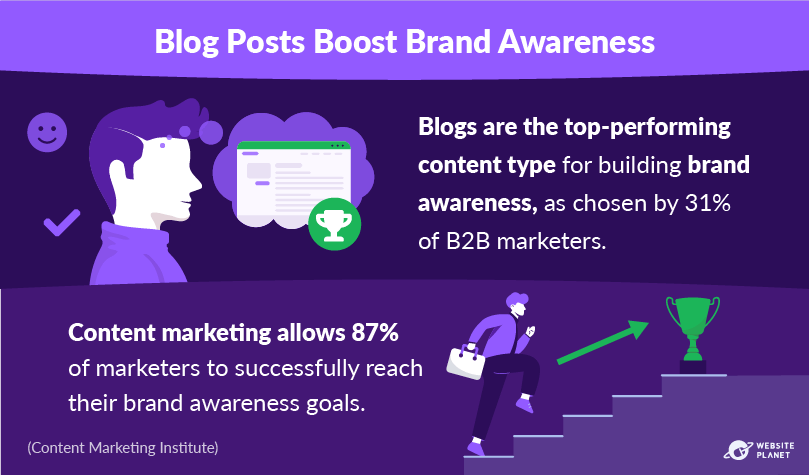 Blogs build brand awareness amongst customers. They can be used as a form of marketing that spreads a brand’s message, expertise, and value by delivering helpful and informative content.
Brands that produce excellent blog content can expect to enjoy more page views, social shares, and overall engagement. They can also expect these readers to tell their friends about the fantastic company that solved their issue, spreading the word and driving future business.
Blogs build brand awareness amongst customers. They can be used as a form of marketing that spreads a brand’s message, expertise, and value by delivering helpful and informative content.
Brands that produce excellent blog content can expect to enjoy more page views, social shares, and overall engagement. They can also expect these readers to tell their friends about the fantastic company that solved their issue, spreading the word and driving future business.
20. Blogs Add Credibility
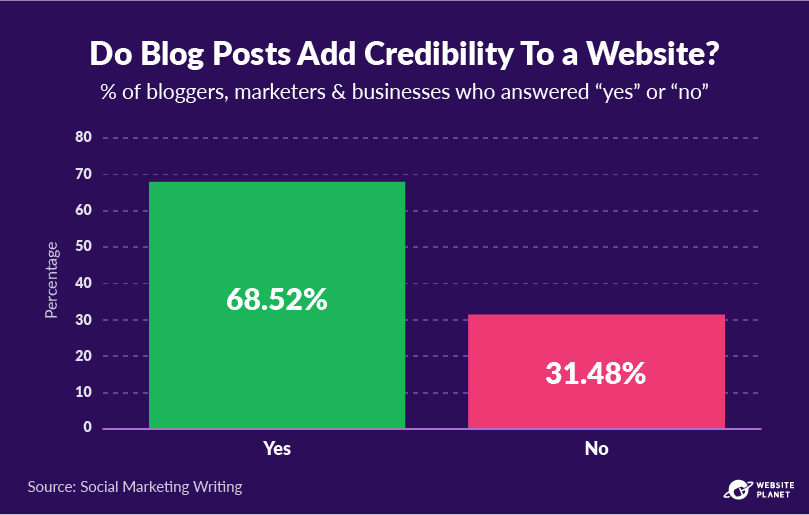 Blogs lift the reputation of your blog site, store, or business.
Of course, there are many sales metrics that blogging can help you boost (we’ll come to those in a minute), but building credibility for your site is an effect every blogger will notice.
Blog content informs, interests, and entertains readers. By providing a valuable experience to the reader, you can build trust amongst a user base of niche enthusiasts or potential customers.
Blogs lift the reputation of your blog site, store, or business.
Of course, there are many sales metrics that blogging can help you boost (we’ll come to those in a minute), but building credibility for your site is an effect every blogger will notice.
Blog content informs, interests, and entertains readers. By providing a valuable experience to the reader, you can build trust amongst a user base of niche enthusiasts or potential customers.
21. Blogs Breed Loyal Customers
 Brands build trust and foster connections with readers through blog content. In fact, 70% of consumers say they feel more connected to brands that produce content (Demand Metric).
Customer loyalty has a massive impact on the future success of a business. Loyal customers will talk about your products, spend more money, and stick with your brand through thick and thin.
According to another study, engaging customers will make them 5 times more likely to become repeat buyers. Highly engaged customers will buy 90% more often and spend 60% more per sale (Rosetta Consulting).
In other words, building a loyal and engaged audience with content can have huge knock-on effects!
Brands build trust and foster connections with readers through blog content. In fact, 70% of consumers say they feel more connected to brands that produce content (Demand Metric).
Customer loyalty has a massive impact on the future success of a business. Loyal customers will talk about your products, spend more money, and stick with your brand through thick and thin.
According to another study, engaging customers will make them 5 times more likely to become repeat buyers. Highly engaged customers will buy 90% more often and spend 60% more per sale (Rosetta Consulting).
In other words, building a loyal and engaged audience with content can have huge knock-on effects!
22. Blogs Get Backlinks
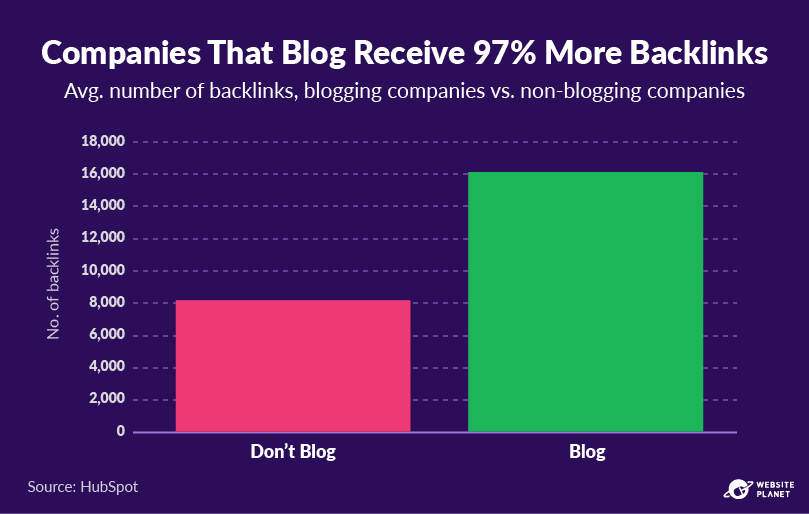 Producing compelling content on a blog will generate a bunch of backlinks to your site. This is important because it signals the page’s authority to Google, or any other search engine for that matter.
Being an authority on a given topic, sector, or niche is essential for search engine optimization (SEO). Being an authority is also crucial for your page, especially a brand page. Backlinks are going to show visitors that you know what you’re talking about.
Backlinks are a crucial driver in Google’s algorithm. Acquiring them is essential because they’re going to help your blog rise through the rankings.
Like the next 2 impacts, this effect applies to all websites (not just business ones).
Producing compelling content on a blog will generate a bunch of backlinks to your site. This is important because it signals the page’s authority to Google, or any other search engine for that matter.
Being an authority on a given topic, sector, or niche is essential for search engine optimization (SEO). Being an authority is also crucial for your page, especially a brand page. Backlinks are going to show visitors that you know what you’re talking about.
Backlinks are a crucial driver in Google’s algorithm. Acquiring them is essential because they’re going to help your blog rise through the rankings.
Like the next 2 impacts, this effect applies to all websites (not just business ones).
23. Blogs Have Indexed Pages
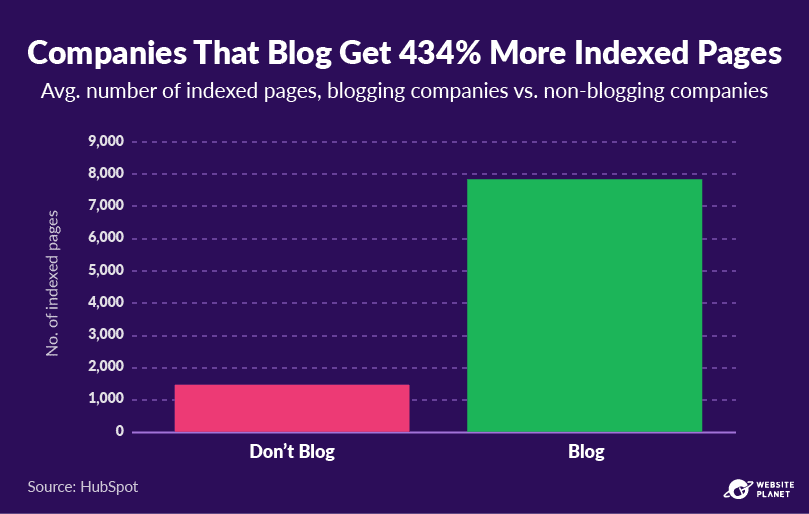 Blogging also increases the number of indexed pages your site has on a search engine by 434%.
With more pages on the internet, visitors have a higher chance of landing on your site and seeing your products or services.
Blogging also increases the number of indexed pages your site has on a search engine by 434%.
With more pages on the internet, visitors have a higher chance of landing on your site and seeing your products or services.
24. Businesses That Blog Boost Traffic
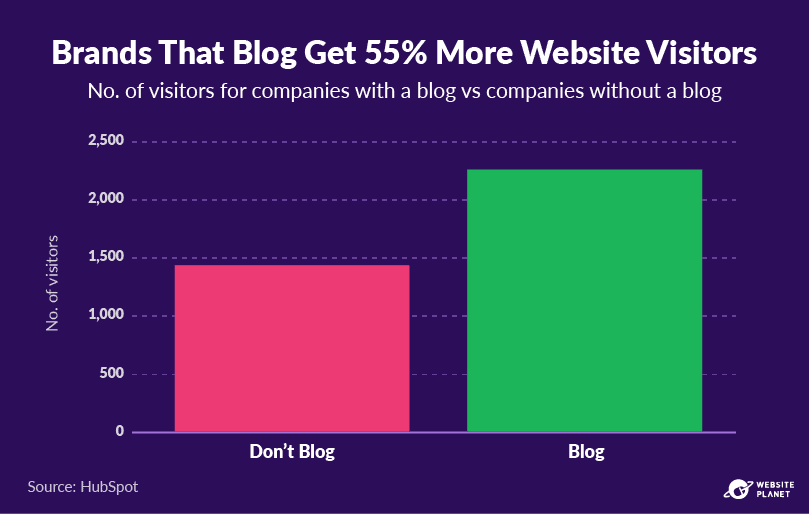 Blogging boosts site traffic by increasing SEO. More people are finding your site through search engines and backlinks, increasing traffic to your site.
There’s a direct link between blogging and site traffic. Increasing the number of blogs on your page by 100% will yield a 300% increase in traffic.
Blogging boosts site traffic by increasing SEO. More people are finding your site through search engines and backlinks, increasing traffic to your site.
There’s a direct link between blogging and site traffic. Increasing the number of blogs on your page by 100% will yield a 300% increase in traffic.
25. Blogging Generates Leads
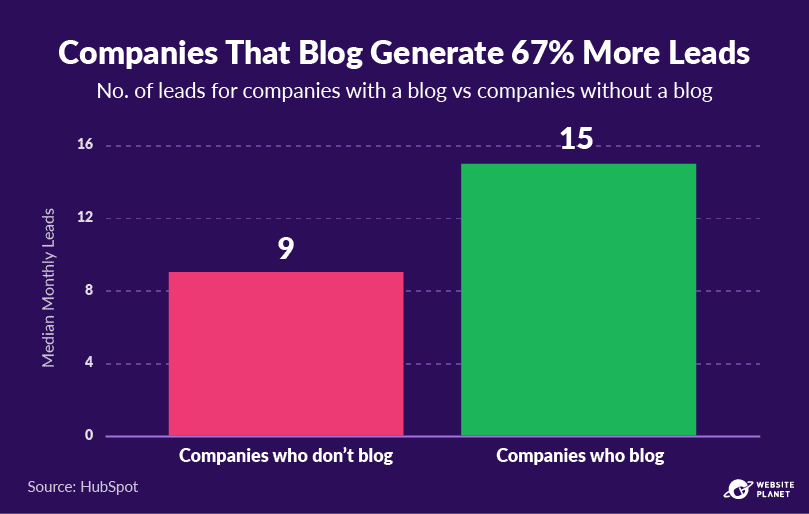 Branded sites that experience an increase in traffic stand to see positive knock-on effects.
More site visitors mean more people are engaging with branded content, more people are becoming aware of the brand, and more people are growing interested in the service/product in question.
When you write a good blog piece, it can generate 3X the leads of paid advertising methods. This explains why 59% of B2B marketers say blogging is the best way to increase their audience (Demand Metric).
Branded sites that experience an increase in traffic stand to see positive knock-on effects.
More site visitors mean more people are engaging with branded content, more people are becoming aware of the brand, and more people are growing interested in the service/product in question.
When you write a good blog piece, it can generate 3X the leads of paid advertising methods. This explains why 59% of B2B marketers say blogging is the best way to increase their audience (Demand Metric).
26. Blogging Gives Amazing ROI
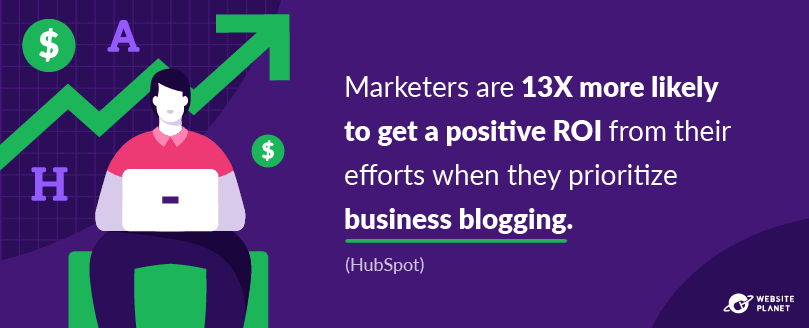 When you acquire more leads, you have more potential customers to convert through CTAs and popups.
The relatively inexpensive cost of content creation, coupled with its effect on leads and sales, means content marketing (and blogging in particular) has an outstanding return on investment.
Marketers are far more likely to see successful results if blogging is part of their strategy. It really is that important.
When you acquire more leads, you have more potential customers to convert through CTAs and popups.
The relatively inexpensive cost of content creation, coupled with its effect on leads and sales, means content marketing (and blogging in particular) has an outstanding return on investment.
Marketers are far more likely to see successful results if blogging is part of their strategy. It really is that important.
27. Industry Blog Traffic by Device
 We’ll now look at some of the different trends between industries. One study looks at the types of devices that are connecting to industry blogs. In general, data shows that most people connect to blogs on their desktop computers.
That is different for a couple of sectors. Jewelers experience massive mobile traffic (58.74%) as many people love to shop for jewelry on their mobile phones.
Travel sector blogs also experience a lot of mobile traffic, while a staggering 84% of traffic to marketing industry blogs comes from mobile phones.
We’ll now look at some of the different trends between industries. One study looks at the types of devices that are connecting to industry blogs. In general, data shows that most people connect to blogs on their desktop computers.
That is different for a couple of sectors. Jewelers experience massive mobile traffic (58.74%) as many people love to shop for jewelry on their mobile phones.
Travel sector blogs also experience a lot of mobile traffic, while a staggering 84% of traffic to marketing industry blogs comes from mobile phones.
28. Industry Blog Traffic by Source
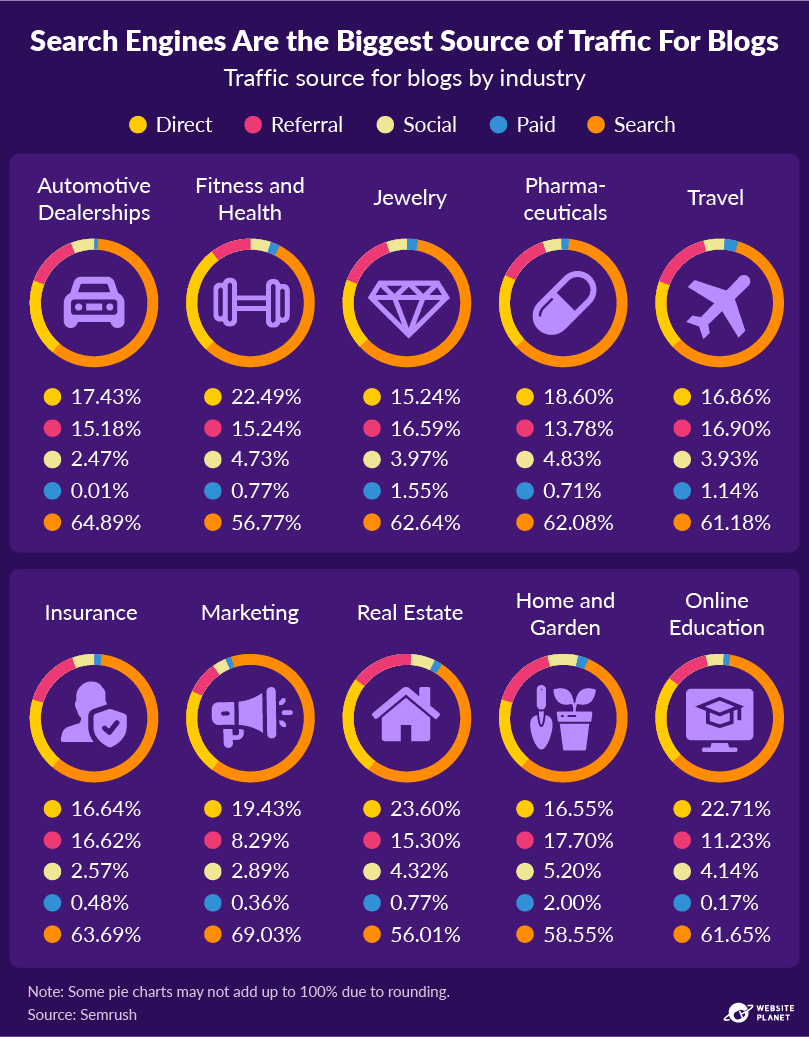 Most industry blogs are generating traffic through organic search. This is why search engine optimization is so essential for a blog.
The amount of blog traffic from paid methods is minuscule, while a decent chunk of industry blog traffic comes from direct mail. Blogging is a direct driver of email traffic; businesses that blog get 2X more email traffic than brands that don’t blog.
Marketing blogs rely on organic search traffic more than others. Home and garden sector blogs get more social media traffic than any other industry.
Most industry blogs are generating traffic through organic search. This is why search engine optimization is so essential for a blog.
The amount of blog traffic from paid methods is minuscule, while a decent chunk of industry blog traffic comes from direct mail. Blogging is a direct driver of email traffic; businesses that blog get 2X more email traffic than brands that don’t blog.
Marketing blogs rely on organic search traffic more than others. Home and garden sector blogs get more social media traffic than any other industry.
29. Top Performing Articles by Industry
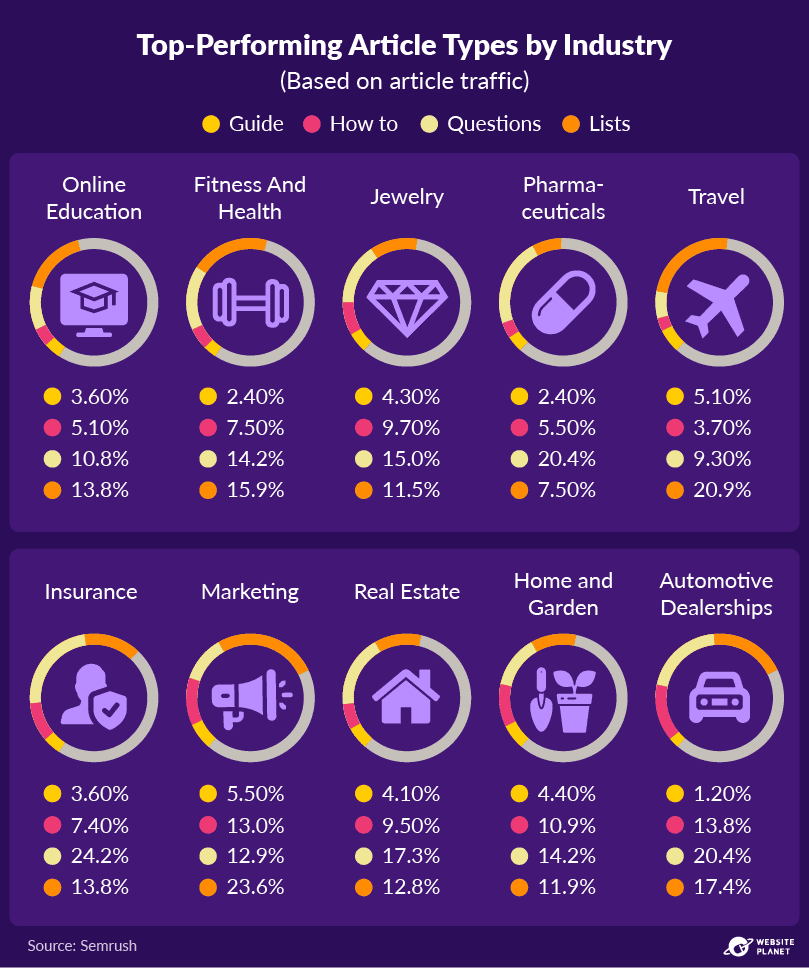 Listicles are technically the top-performing blog posts across most metrics, but how do customers influence what works and what doesn’t across different industries?
List posts are still really popular. In marketing sector blogs, fitness industry blogs, higher education blogs, and travel industry blogs, listicles receive the most traffic.
This form works for these industries; you can understand why “The 10 Best Tropical Destinations” or “The Top 5 Core Exercises” might perform well for travel and fitness blogs.
Questions and How-to articles work well for other industries, however. Question articles, in particular, perform best across all of the industries in Semrush’s study. These get straight to the point when solving customers’ problems.
Listicles are technically the top-performing blog posts across most metrics, but how do customers influence what works and what doesn’t across different industries?
List posts are still really popular. In marketing sector blogs, fitness industry blogs, higher education blogs, and travel industry blogs, listicles receive the most traffic.
This form works for these industries; you can understand why “The 10 Best Tropical Destinations” or “The Top 5 Core Exercises” might perform well for travel and fitness blogs.
Questions and How-to articles work well for other industries, however. Question articles, in particular, perform best across all of the industries in Semrush’s study. These get straight to the point when solving customers’ problems.
30. Best Length by Industry
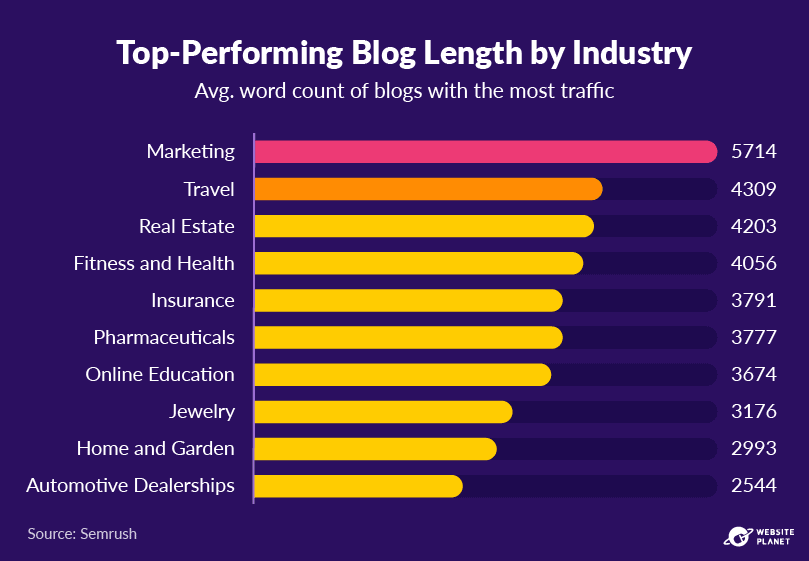 The best-performing posts vary in length between different industry blogs. In general, longer content performs best.
How long is too long? Well, for marketing sector blogs, “too long” is not really an issue. The marketing blogs with the most traffic are just under 6000 words long on average.
Travel industry blogs should provide loads of information, too, while the best real estate industry blogs are around 4200 words long.
Car dealership blogs are the shortest among those tested in the study. The best-performing blogs from car dealerships are often around 2,500 words long.
The best-performing posts vary in length between different industry blogs. In general, longer content performs best.
How long is too long? Well, for marketing sector blogs, “too long” is not really an issue. The marketing blogs with the most traffic are just under 6000 words long on average.
Travel industry blogs should provide loads of information, too, while the best real estate industry blogs are around 4200 words long.
Car dealership blogs are the shortest among those tested in the study. The best-performing blogs from car dealerships are often around 2,500 words long.
31. B2C Articles Are Shareable
 One of the key differences between B2B and B2C content is shareability. In the B2C sector, readers share blog content much more often.
This makes sense because B2C blogs cover topics of a general appeal. Articles on fitness or food are likely to appeal to more people than, say, a B2B article about branding.
However, B2B marketers should still focus on creating shareable content that covers topics in-depth.
One report found that blog posts were the most shared content type in B2B. 74% of B2B marketers share blog posts with their colleagues (DemandGen).
This is because B2B readers need to discuss brands, products, and topics with colleagues before they make a purchase, so make sure B2B content covers all bases!
One of the key differences between B2B and B2C content is shareability. In the B2C sector, readers share blog content much more often.
This makes sense because B2C blogs cover topics of a general appeal. Articles on fitness or food are likely to appeal to more people than, say, a B2B article about branding.
However, B2B marketers should still focus on creating shareable content that covers topics in-depth.
One report found that blog posts were the most shared content type in B2B. 74% of B2B marketers share blog posts with their colleagues (DemandGen).
This is because B2B readers need to discuss brands, products, and topics with colleagues before they make a purchase, so make sure B2B content covers all bases!
32. What Are Marketers Doing Wrong?
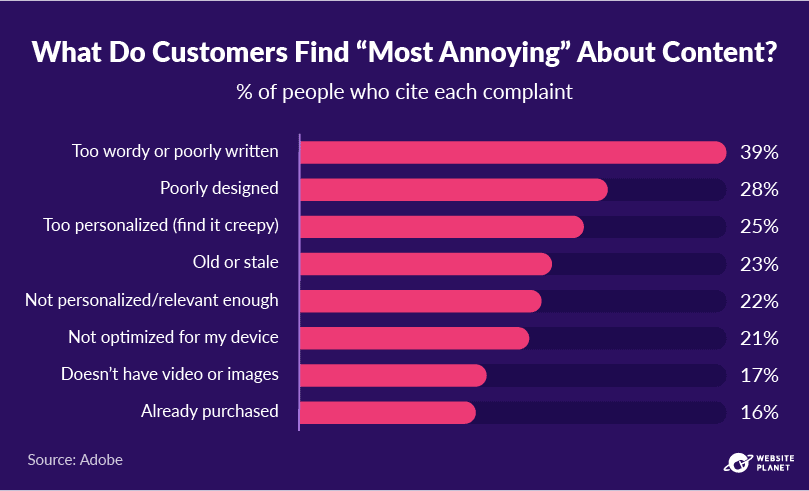 B2C blog writers need to focus on a host of other elements in their content.
39% of customers find it annoying when a business’ blog content is too wordy or poorly written. Poor design hinders 28% of consumers, while over-personalization can creep out 25% of people. Lack of content relevance and poor optimization also feature as grievances for B2C blog readers.
Marketers should focus on getting this stuff right. 3 out of 5 consumers in Adobe’s survey said just one of these issues would convince them not to purchase.
B2C blog writers need to focus on a host of other elements in their content.
39% of customers find it annoying when a business’ blog content is too wordy or poorly written. Poor design hinders 28% of consumers, while over-personalization can creep out 25% of people. Lack of content relevance and poor optimization also feature as grievances for B2C blog readers.
Marketers should focus on getting this stuff right. 3 out of 5 consumers in Adobe’s survey said just one of these issues would convince them not to purchase.
Niche Blogging Stats
Niche blogging refers to blogs covering a particular niche topic with their content, such as food, lifestyle, fitness, or fashion. For the record, business blogs can cover a niche topic, too. Usually, the sector in which that business operates. Though, business blogs are ultimately concerned with generating leads and boosting brand awareness. Meanwhile, niche blogs can cover a range of areas within a topic and aim to provide a website experience where content is the main feature (like an online magazine). Niche blogs are not always motivated by money.33. The Most Popular Niches
 So, what blogging niches are popular amongst users?
Food blogs are, by quite some distance, the most popular niche. 42% of niche blogs with the most traffic are food blogs. People love to learn about food on the internet!
Other popular niches include lifestyle/mom blogs, travel blogs, and arts & crafts blogs. In fact, the top 4 most popular niches account for 74% of all high-traffic niche blogs.
That would suggest targeting one of these niches is a good idea if you want big results.
So, what blogging niches are popular amongst users?
Food blogs are, by quite some distance, the most popular niche. 42% of niche blogs with the most traffic are food blogs. People love to learn about food on the internet!
Other popular niches include lifestyle/mom blogs, travel blogs, and arts & crafts blogs. In fact, the top 4 most popular niches account for 74% of all high-traffic niche blogs.
That would suggest targeting one of these niches is a good idea if you want big results.
34. The Most Popular Niches For New Blogs
 Everyone has to start somewhere, and that’s particularly true for bloggers. Just 21.8% of bloggers have been writing posts for 5 years or more (Blog Tyrant).
Choosing which niche is best for you is a different matter altogether. The data suggests most blog startups are lifestyle/mom blogs, which account for 25% of all new blogs in the last 12 months.
Travel blogs are the next in-vogue niche, while food blogs rank third amongst new blogs. Surprising (given their popularity), but this suggests the food blog market is oversaturated.
Beauty/fashion and health/fitness make an appearance in the top 5. These are 2 hot topics right now, particularly health and fitness, and both could see continued growth over the next few years.
Everyone has to start somewhere, and that’s particularly true for bloggers. Just 21.8% of bloggers have been writing posts for 5 years or more (Blog Tyrant).
Choosing which niche is best for you is a different matter altogether. The data suggests most blog startups are lifestyle/mom blogs, which account for 25% of all new blogs in the last 12 months.
Travel blogs are the next in-vogue niche, while food blogs rank third amongst new blogs. Surprising (given their popularity), but this suggests the food blog market is oversaturated.
Beauty/fashion and health/fitness make an appearance in the top 5. These are 2 hot topics right now, particularly health and fitness, and both could see continued growth over the next few years.
35. There’s Value in Targeting a Niche
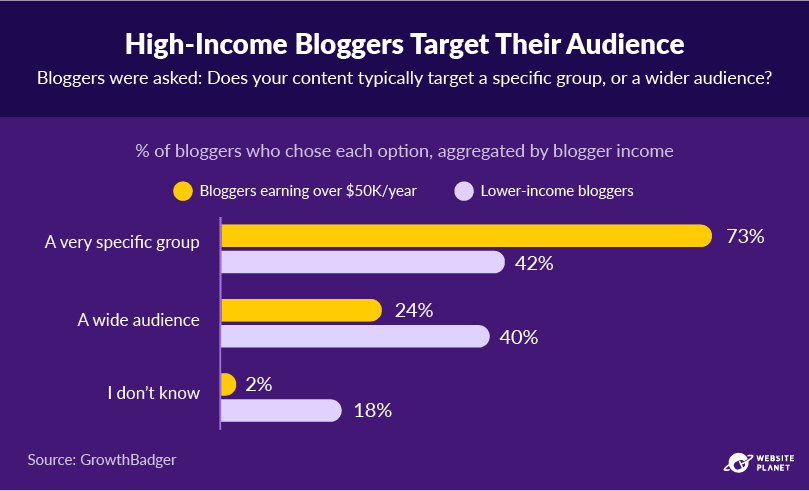 The highest-earning bloggers focus on a very specific target audience with their content. This is why niche blogging can be such a lucrative business.
73% of high-income bloggers target a specific audience compared to just 42% of low-income bloggers.
The results show that appealing to the few is better than trying to appease everyone. It’s difficult to keep everyone happy with your content, so pick a specific topic and target that audience!
The highest-earning bloggers focus on a very specific target audience with their content. This is why niche blogging can be such a lucrative business.
73% of high-income bloggers target a specific audience compared to just 42% of low-income bloggers.
The results show that appealing to the few is better than trying to appease everyone. It’s difficult to keep everyone happy with your content, so pick a specific topic and target that audience!
36. The Most Profitable Niches
 If monetary gains are your motivation for blogging, research suggests these 4 topics are the best blogs for generating income.
Food blogs make the most money, earning $9169 per month on average. Personal finance blogs are profitable, too, bringing in around $9100 per month.
The next 2 profitable niches are lifestyle/mommy and travel, making $5174/mth and $5000/mth, respectively.
Marketing blogs didn’t make it into the top 4, but they rank fifth, raking in around $4,269/mth.
If monetary gains are your motivation for blogging, research suggests these 4 topics are the best blogs for generating income.
Food blogs make the most money, earning $9169 per month on average. Personal finance blogs are profitable, too, bringing in around $9100 per month.
The next 2 profitable niches are lifestyle/mommy and travel, making $5174/mth and $5000/mth, respectively.
Marketing blogs didn’t make it into the top 4, but they rank fifth, raking in around $4,269/mth.
37. Profitable Niches Sell Online Courses
 Niche blogs need to diversify their income streams to make a profit in 2021.
Niche blogs can make money through ad monetization, sponsored posts, affiliate marketing, and consultations, but there is one common focus amongst the best niche blogs: online courses.
Great blogs demonstrate expertise within their niche, and using this knowledge to create an online course is a no-brainer. That’s why 100% of top-earning blogs make money from online courses instead of 45% of middle-income blogs and 12% of lower-income blogs.
High-income blogs make 80% of their income from online courses. Middle-income blogs make just 10% of revenue from online courses, while smaller blogs make 3% of their income.
Niche blogs need to diversify their income streams to make a profit in 2021.
Niche blogs can make money through ad monetization, sponsored posts, affiliate marketing, and consultations, but there is one common focus amongst the best niche blogs: online courses.
Great blogs demonstrate expertise within their niche, and using this knowledge to create an online course is a no-brainer. That’s why 100% of top-earning blogs make money from online courses instead of 45% of middle-income blogs and 12% of lower-income blogs.
High-income blogs make 80% of their income from online courses. Middle-income blogs make just 10% of revenue from online courses, while smaller blogs make 3% of their income.
38. Popular Ad Management Platforms
 Talking of income sources, which ad management platforms are blogs using?
Top bloggers prefer Mediavine and AdThrive over Google AdSense in 2021. 40% of top bloggers use Mediavine, while 32% use AdThrive.
Together, 72% of top bloggers use these two platforms instead of 21% of those who use AdSense.
Data suggests AdThrive is the best ad management platform for top bloggers. Among those surveyed, AdThrive accounted for 60% of users’ ad income, while MediaVine brought 36% of users’ overall ad income.
Talking of income sources, which ad management platforms are blogs using?
Top bloggers prefer Mediavine and AdThrive over Google AdSense in 2021. 40% of top bloggers use Mediavine, while 32% use AdThrive.
Together, 72% of top bloggers use these two platforms instead of 21% of those who use AdSense.
Data suggests AdThrive is the best ad management platform for top bloggers. Among those surveyed, AdThrive accounted for 60% of users’ ad income, while MediaVine brought 36% of users’ overall ad income.
39. Travel Content Growth
 Travel enthusiasts do a lot of research online as part of their holiday planning. So, it stands to good reason that travel blogs are receiving more traffic as a result.
Travel is one of those industries that is well-suited to an online user experience. After all, travelers have been booking holidays online for a long time. Now they’re researching online too. More than 80% of travel planning is done online, while 49% of travel planners visit a travel blog for information.
Expect the travel niche to continue to grow over the next few years. Travel was the second most popular niche in 2020 for a reason!
Travel enthusiasts do a lot of research online as part of their holiday planning. So, it stands to good reason that travel blogs are receiving more traffic as a result.
Travel is one of those industries that is well-suited to an online user experience. After all, travelers have been booking holidays online for a long time. Now they’re researching online too. More than 80% of travel planning is done online, while 49% of travel planners visit a travel blog for information.
Expect the travel niche to continue to grow over the next few years. Travel was the second most popular niche in 2020 for a reason!
40. The Best Travel Socials
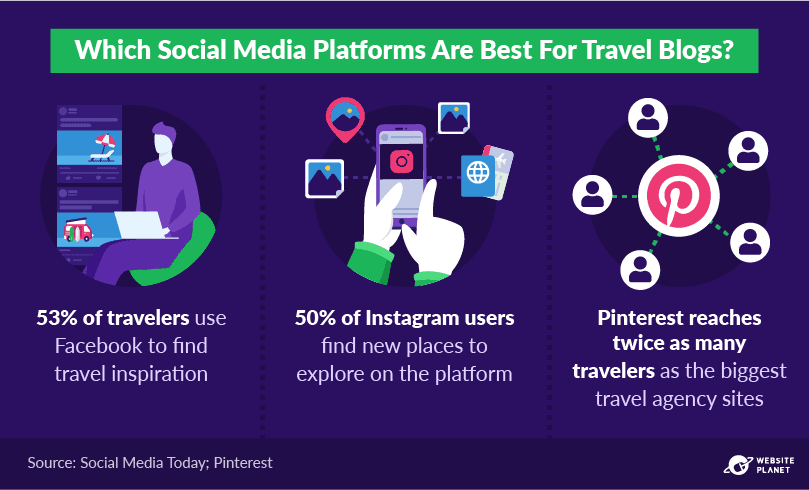 What socials work best when promoting a travel blog? The demographics and overall reach of Facebook, Instagram, and Pinterest suggest these are the best places to market travel content.
Users look to Facebook for holiday inspiration, while the number of online travelers on Pinterest suggests this is another excellent social site to target.
The buzzword for travel marketing on Instagram is “discovery.” People go to Instagram to discover new things, whether a local bar or a tropical destination. Travel bloggers need to leverage this zest for adventure with their marketing efforts.
What socials work best when promoting a travel blog? The demographics and overall reach of Facebook, Instagram, and Pinterest suggest these are the best places to market travel content.
Users look to Facebook for holiday inspiration, while the number of online travelers on Pinterest suggests this is another excellent social site to target.
The buzzword for travel marketing on Instagram is “discovery.” People go to Instagram to discover new things, whether a local bar or a tropical destination. Travel bloggers need to leverage this zest for adventure with their marketing efforts.
41. Give Travel Searchers Answers
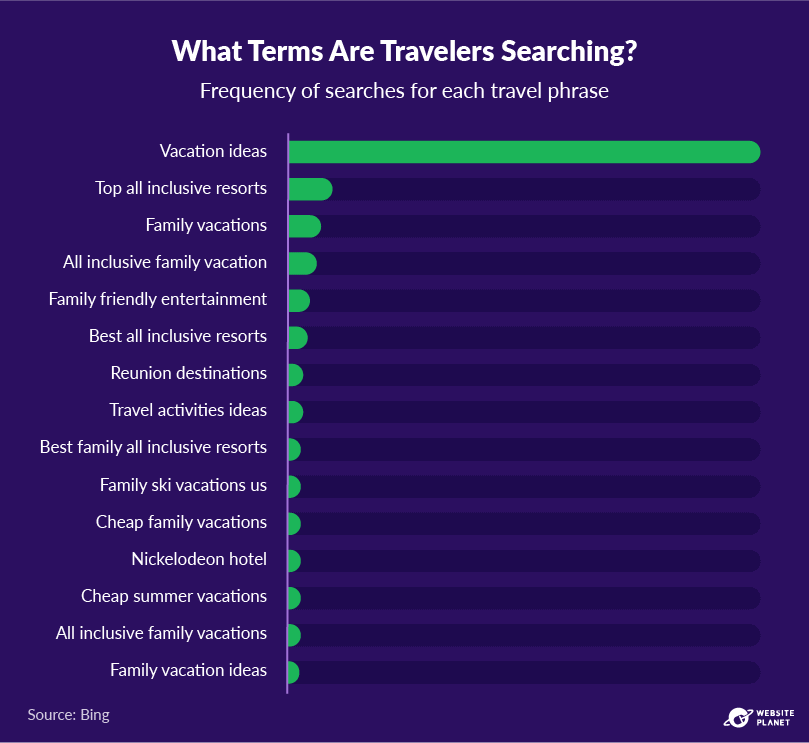 Travel searchers are looking for specific answers. Bloggers need to cater to these questions through travel content.
Travelers are searching for “vacation ideas,” and, by some distance, this is the most common search query. That means travel blogs should be producing plenty of listicles offering the low-down on destinations.
“Family vacations” featured in the top 3 travel searches, while “cheap family vacations” was the search term to see the largest growth in another part of Bing’s study.
Modeling travel blogs to have a family feel should help then, while it’s also worth considering that 68% of travel searchers are female.
Travel searchers are looking for specific answers. Bloggers need to cater to these questions through travel content.
Travelers are searching for “vacation ideas,” and, by some distance, this is the most common search query. That means travel blogs should be producing plenty of listicles offering the low-down on destinations.
“Family vacations” featured in the top 3 travel searches, while “cheap family vacations” was the search term to see the largest growth in another part of Bing’s study.
Modeling travel blogs to have a family feel should help then, while it’s also worth considering that 68% of travel searchers are female.
42. Recipe Posts
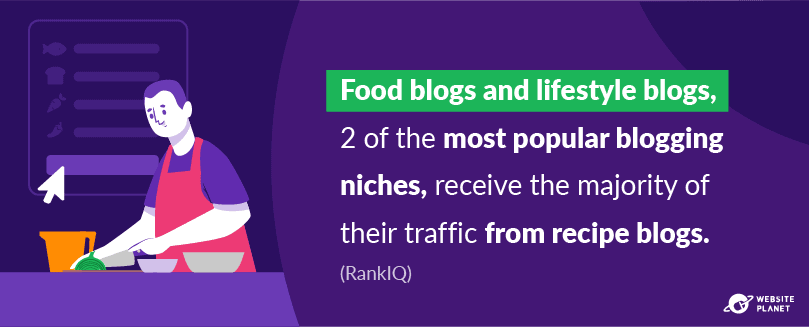 Recipe posts are one of the most popular types of articles that niches can produce. Food blogs and lifestyle blogs receive most of their traffic from recipe posts.
Recipes are popular because, just like travelers, home cooks do their research online. 89% of people look for recipes on the internet, while 79% read blogs for recipes and information about food (Stella Rising).
Recipe posts are one of the most popular types of articles that niches can produce. Food blogs and lifestyle blogs receive most of their traffic from recipe posts.
Recipes are popular because, just like travelers, home cooks do their research online. 89% of people look for recipes on the internet, while 79% read blogs for recipes and information about food (Stella Rising).
43. Food Blogs Use Ads
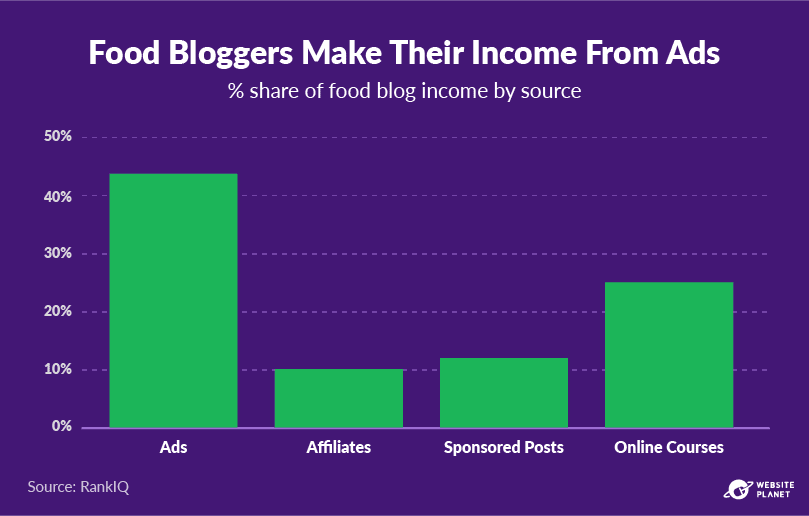 Unlike most other niches, food bloggers make their money primarily from advertising revenue.
42% of food niche income comes from ads, while just 10% of food niche income comes from affiliates. This is the largest difference compared to any other niche, and points to the fantastic traffic that food blogs generate.
Online courses, again, make up a significant portion of income for food blogs.
Unlike most other niches, food bloggers make their money primarily from advertising revenue.
42% of food niche income comes from ads, while just 10% of food niche income comes from affiliates. This is the largest difference compared to any other niche, and points to the fantastic traffic that food blogs generate.
Online courses, again, make up a significant portion of income for food blogs.
44. Top Fitness Keywords
 These key terms would be difficult to rank with your content, but being aware of popular search terms gives us a good idea of what health and fitness buffs are looking for when they search.
Health-related fitness is an interesting term that pops up often. Writing content on specific areas/topics within HRF could be niche enough to rank well while catering to many searchers.
These key terms would be difficult to rank with your content, but being aware of popular search terms gives us a good idea of what health and fitness buffs are looking for when they search.
Health-related fitness is an interesting term that pops up often. Writing content on specific areas/topics within HRF could be niche enough to rank well while catering to many searchers.
45. Finance Blogs Use Affiliate Marketing
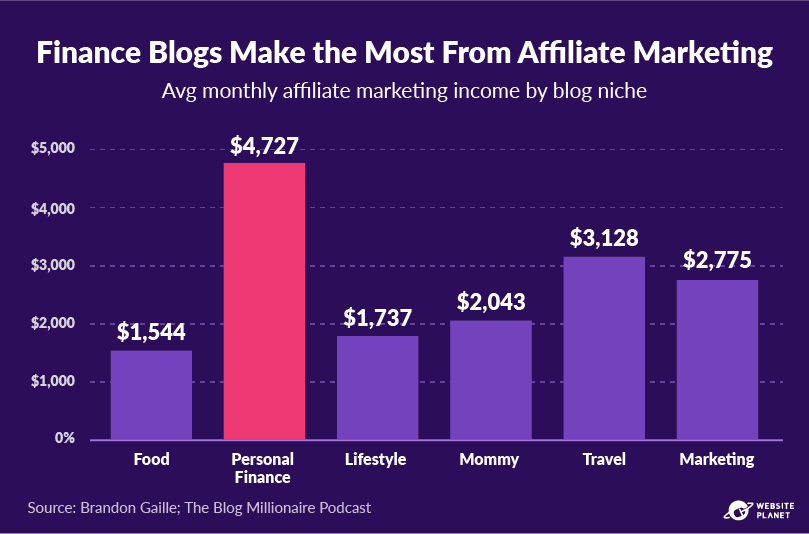 In stark contrast to the food blogging niche, personal finance blogs earn the most from affiliate marketing.
Affiliate marketing outlines a situation where marketers pay others (i.e., bloggers) to market their products/services for them.
Personal finance blogs make a whopping $4727 per month from affiliate marketing — that’s more than any other niche!
Travel blogs earn a lot from affiliate methods, while food blogs, lifestyle blogs, and mommy blogs don’t bother too much with affiliate programs.
That owes to the diversity with which bloggers can earn their money. Each separate niche seems to have a different source of income!
In stark contrast to the food blogging niche, personal finance blogs earn the most from affiliate marketing.
Affiliate marketing outlines a situation where marketers pay others (i.e., bloggers) to market their products/services for them.
Personal finance blogs make a whopping $4727 per month from affiliate marketing — that’s more than any other niche!
Travel blogs earn a lot from affiliate methods, while food blogs, lifestyle blogs, and mommy blogs don’t bother too much with affiliate programs.
That owes to the diversity with which bloggers can earn their money. Each separate niche seems to have a different source of income!
The Current State of Blogging
Here we’ll take a look at some general (non-industry specific) practices amongst bloggers and marketers.46. Blog Marketing Channels
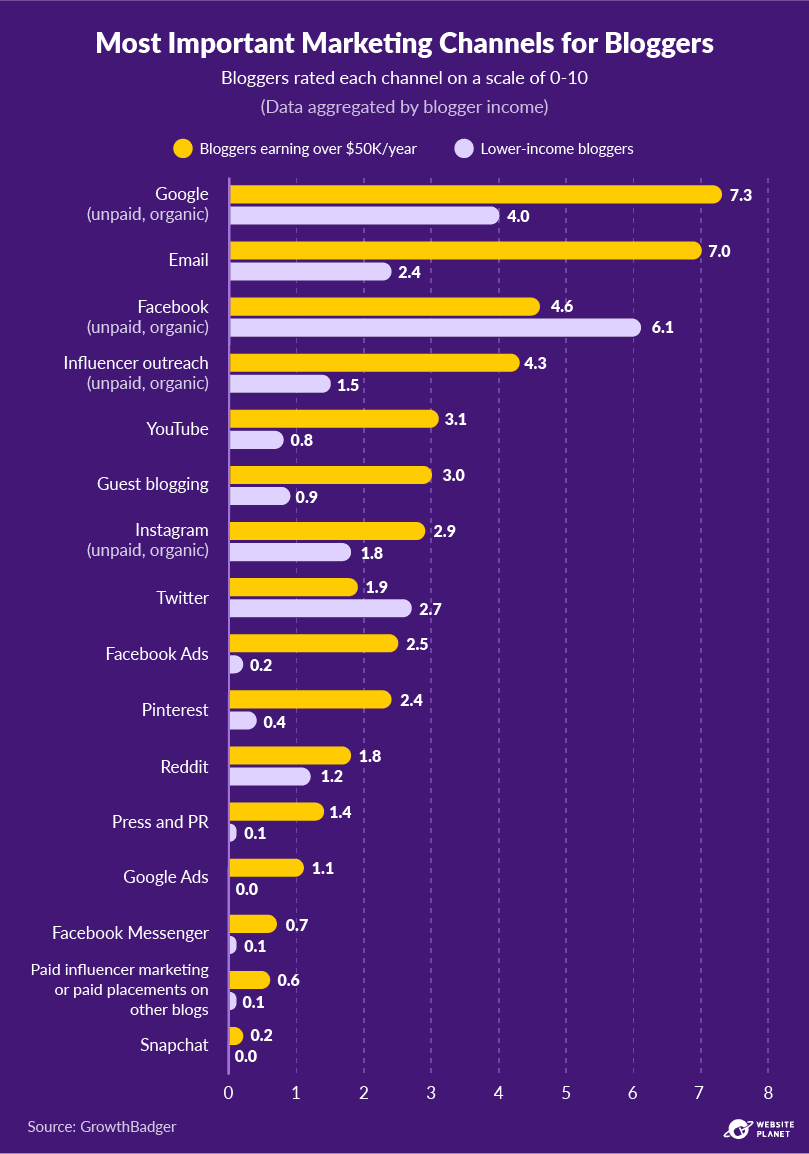 Bloggers are catching on to the fact that they need to market their blogs to get the best results.
That’s why there’s been a 93% increase in the number of blogs employing promotional tactics, such as paid ads, to drive traffic over the last year (OptinMonster).
That being said, Google is undoubtedly still the top marketing channel for bloggers. Google rankings bring in a vast amount of traffic.
Social media is another popular avenue. 97% of bloggers promote through social media sites (Statista). The very best bloggers are focusing on YouTube, Instagram, and Pinterest more than others.
Though LinkedIn doesn’t appear on this list, you can be confident that B2B marketers will promote their blog on this platform. 96% of B2B marketers share organic content on LinkedIn (CMI).
Bloggers are catching on to the fact that they need to market their blogs to get the best results.
That’s why there’s been a 93% increase in the number of blogs employing promotional tactics, such as paid ads, to drive traffic over the last year (OptinMonster).
That being said, Google is undoubtedly still the top marketing channel for bloggers. Google rankings bring in a vast amount of traffic.
Social media is another popular avenue. 97% of bloggers promote through social media sites (Statista). The very best bloggers are focusing on YouTube, Instagram, and Pinterest more than others.
Though LinkedIn doesn’t appear on this list, you can be confident that B2B marketers will promote their blog on this platform. 96% of B2B marketers share organic content on LinkedIn (CMI).
47. YouTube Is Increasingly Important
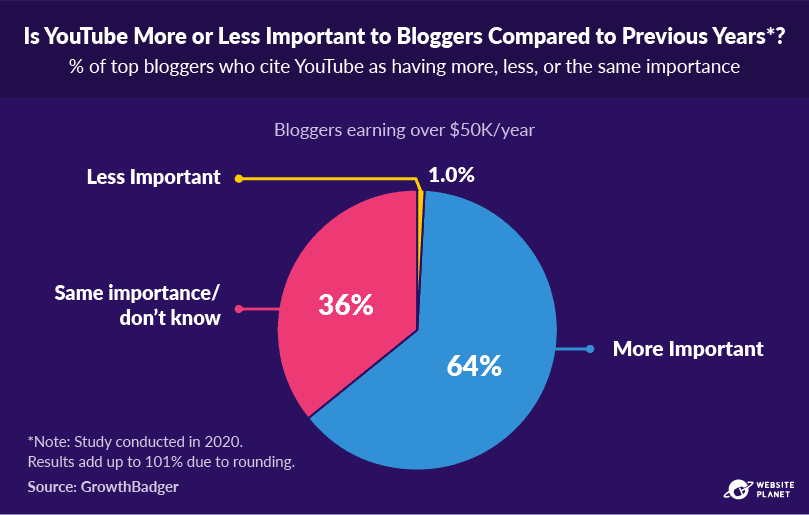 YouTube became a more important platform for top bloggers in 2020. A rise in usage amongst bloggers coincides with an increase in social and streamed video consumption; the same year saw Netflix, Disney+, and TikTok enjoy record viewership.
YouTube has been another beneficiary of 2020’s streaming craze. It’s the biggest video streaming platform globally, with users watching a combined 1 billion hours of video every day.
As users continue to demand more video, expect more bloggers to market through the platform.
Some bloggers are even turning their articles into videos and posting them through social platforms — this can drive engagement and increase content reach.
YouTube became a more important platform for top bloggers in 2020. A rise in usage amongst bloggers coincides with an increase in social and streamed video consumption; the same year saw Netflix, Disney+, and TikTok enjoy record viewership.
YouTube has been another beneficiary of 2020’s streaming craze. It’s the biggest video streaming platform globally, with users watching a combined 1 billion hours of video every day.
As users continue to demand more video, expect more bloggers to market through the platform.
Some bloggers are even turning their articles into videos and posting them through social platforms — this can drive engagement and increase content reach.
48. Rank Your Content On Page 1
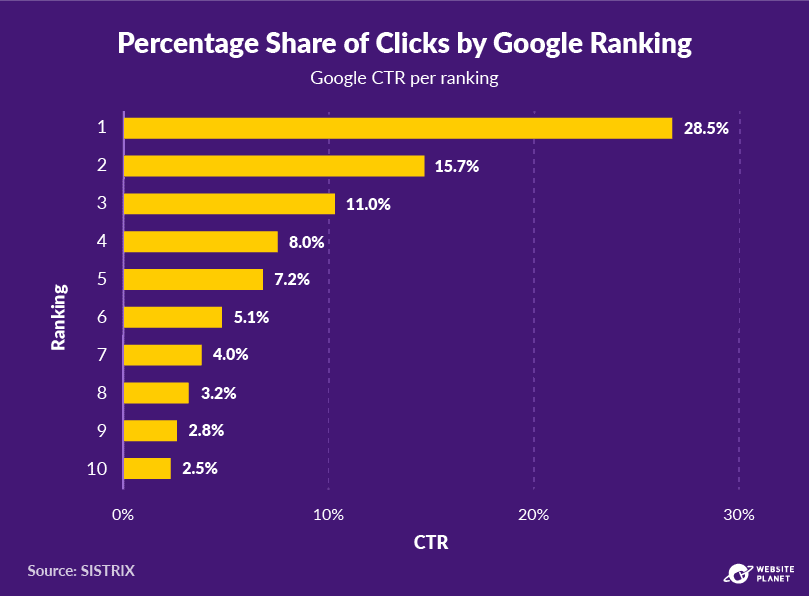 SEO is crucial because it places your blog/content in the shop window. Ranking high vastly increases the chances of someone clicking on your site; more than 50% of all clicks go to the first 3 results on Google.
At the very least, get your blog somewhere onto Google’s first page of results. 88% of searchers never make it off the first page.
SEO is crucial because it places your blog/content in the shop window. Ranking high vastly increases the chances of someone clicking on your site; more than 50% of all clicks go to the first 3 results on Google.
At the very least, get your blog somewhere onto Google’s first page of results. 88% of searchers never make it off the first page.
49. SEO Tactics
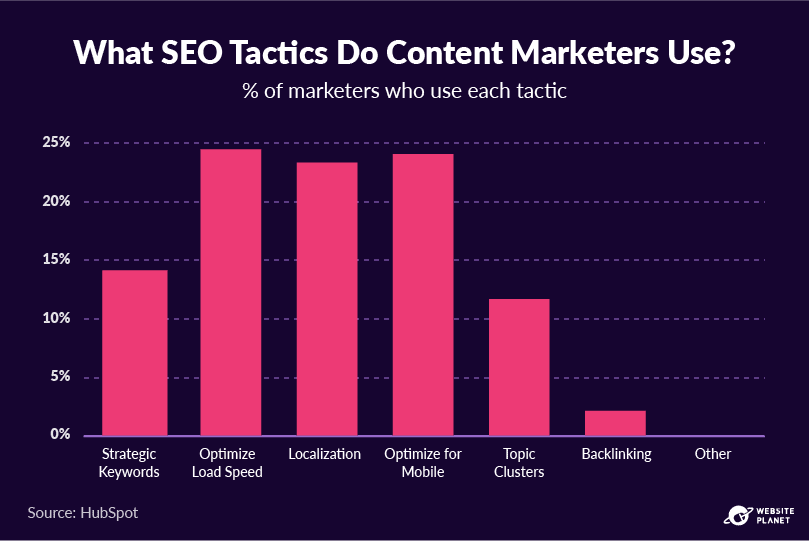 SEO is the most critical marketing method for bloggers. Consistently ranking high on search engines is going to boost performance across every aspect of your site. That’s why 55% of marketers rate SEO as “very” or “extremely” important to their marketing strategy.
SEO leads visitors to convert more often, too, with a 14.6% close rate. SEO greatly improves site traffic and sales performance compared to direct mail, which has a 1.7% close rate.
Site optimization and localization are huge factors in improving the SEO of your site. Keyword rankings and backlinks are also crucial tactics for blog content.
SEO is the most critical marketing method for bloggers. Consistently ranking high on search engines is going to boost performance across every aspect of your site. That’s why 55% of marketers rate SEO as “very” or “extremely” important to their marketing strategy.
SEO leads visitors to convert more often, too, with a 14.6% close rate. SEO greatly improves site traffic and sales performance compared to direct mail, which has a 1.7% close rate.
Site optimization and localization are huge factors in improving the SEO of your site. Keyword rankings and backlinks are also crucial tactics for blog content.
50. Optimize the URL
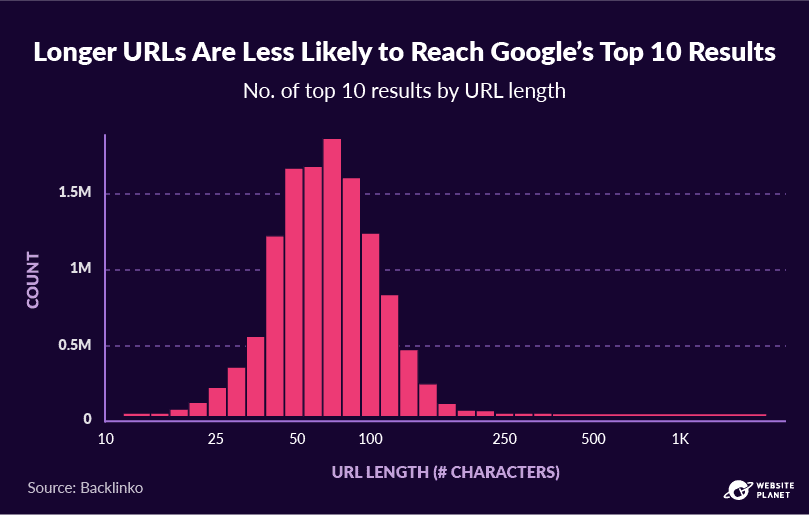 This is one aspect of SEO that not many people talk about, but optimizing the length of your URL is another area that can improve site performance.
In fact, the top 10 results on Google generally have shorter URLs. Backlinko’s study found that the average URL length amongst all top 10 results is 66 characters long — this seems to be the sweet spot.
This is one aspect of SEO that not many people talk about, but optimizing the length of your URL is another area that can improve site performance.
In fact, the top 10 results on Google generally have shorter URLs. Backlinko’s study found that the average URL length amongst all top 10 results is 66 characters long — this seems to be the sweet spot.
51. Top SEO Tools
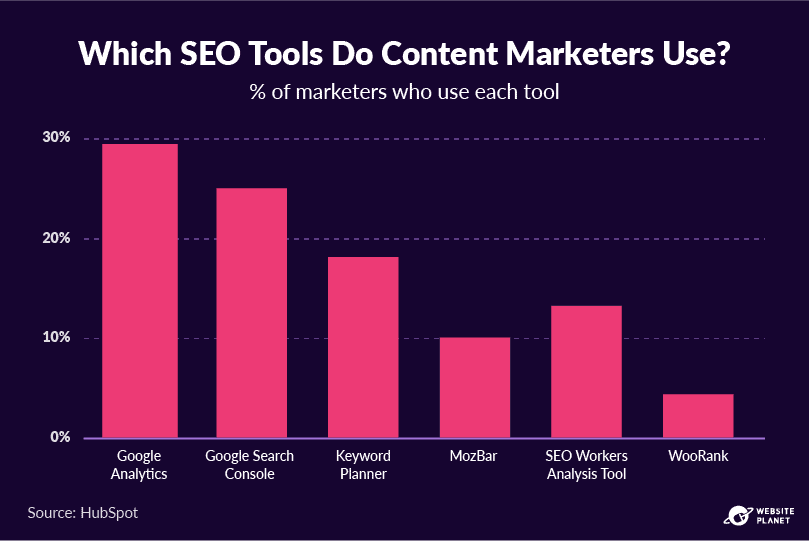 Marketers are using an array of tools to help them boost the SEO performance of their site and content.
The best SEO tool is Google Analytics. Google Analytics allows site owners to track the activity of visitors on-site. This means bloggers can optimize their site and content to cater to the typical behaviors of their audience.
Analytics are effective, and bloggers that employ analytics get great results. 37% of bloggers who “always” use analytics say they get “strong results” (Orbit Media).
Marketers are using an array of tools to help them boost the SEO performance of their site and content.
The best SEO tool is Google Analytics. Google Analytics allows site owners to track the activity of visitors on-site. This means bloggers can optimize their site and content to cater to the typical behaviors of their audience.
Analytics are effective, and bloggers that employ analytics get great results. 37% of bloggers who “always” use analytics say they get “strong results” (Orbit Media).
52. The Best Article Types
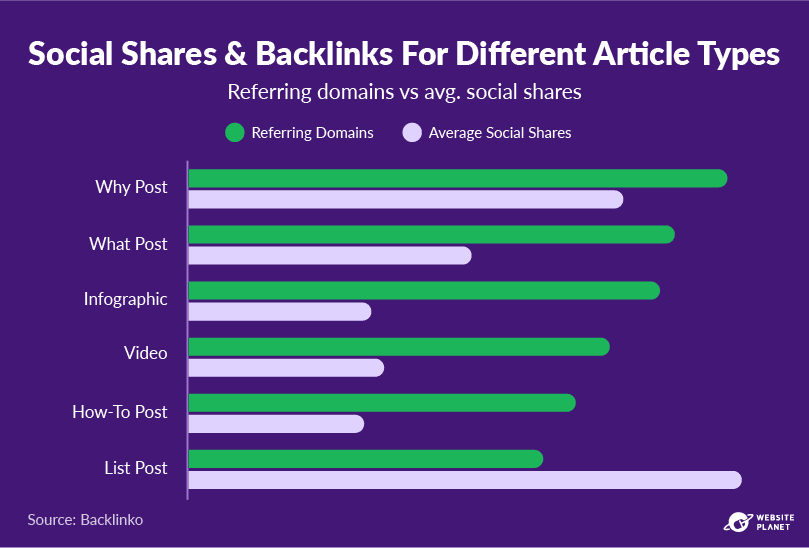 In terms of social shares and backlinks, these are the best-performing article types bloggers can implement into their strategy.
“Why” posts receive the most backlinks and have strong performance across all channels, while list posts perform best on social media — receiving far more shares than any other form.
List posts receive 218% more social media shares than other types of content.
In terms of social shares and backlinks, these are the best-performing article types bloggers can implement into their strategy.
“Why” posts receive the most backlinks and have strong performance across all channels, while list posts perform best on social media — receiving far more shares than any other form.
List posts receive 218% more social media shares than other types of content.
53. Power Posts
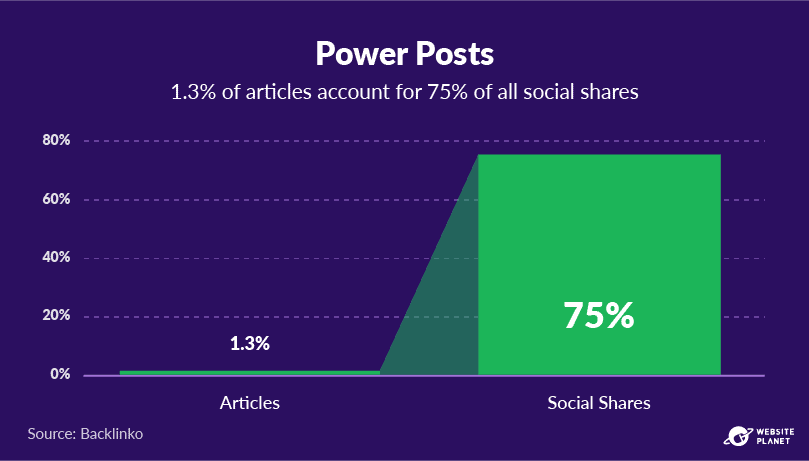 Social shares are not evenly distributed among posts. In the world of blogging, a small number of articles receive the majority of views and engagements.
1.3% of posts generate 75% of all social shares. There are even top-performing posts within this subset of power posts. 0.1% of articles receive 50% of all social media shares.
Other studies have had similar outcomes. HubSpot found that 10% of a site’s blog posts bring in 40% of its traffic, while another study found that 80% of results come from just 20% of blogging efforts (Pareto Principle).
Social shares are not evenly distributed among posts. In the world of blogging, a small number of articles receive the majority of views and engagements.
1.3% of posts generate 75% of all social shares. There are even top-performing posts within this subset of power posts. 0.1% of articles receive 50% of all social media shares.
Other studies have had similar outcomes. HubSpot found that 10% of a site’s blog posts bring in 40% of its traffic, while another study found that 80% of results come from just 20% of blogging efforts (Pareto Principle).
54. Create Compounding Posts
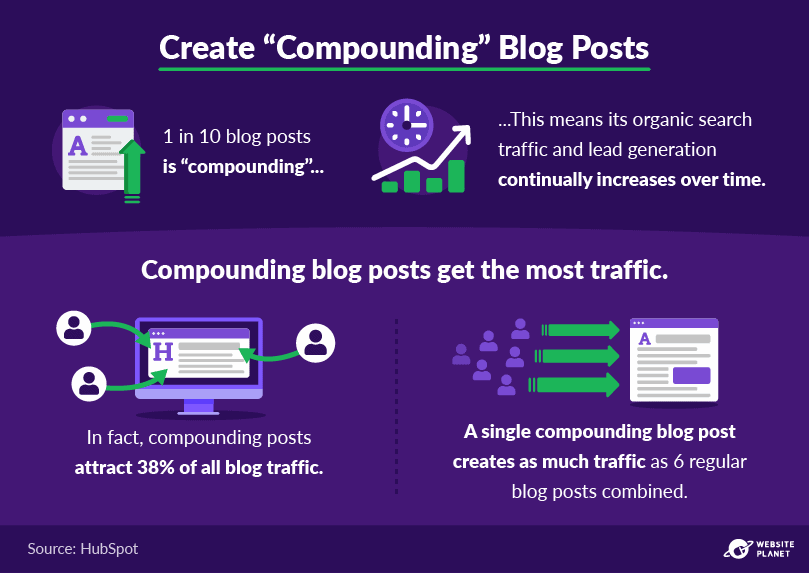 The perfect article is a kind of “viral sensation” that blows everything else out of the water. One such type of post is called a “compounding post.” Compounding posts age like a fine wine, gathering more traffic as time goes on.
Creating content that is compounding should be one of the key aims for bloggers and marketers. Planning a few of these in your strategy will help take your content (and site) into the stratosphere of social engagement and traffic.
The perfect article is a kind of “viral sensation” that blows everything else out of the water. One such type of post is called a “compounding post.” Compounding posts age like a fine wine, gathering more traffic as time goes on.
Creating content that is compounding should be one of the key aims for bloggers and marketers. Planning a few of these in your strategy will help take your content (and site) into the stratosphere of social engagement and traffic.
55. The Traits of a Compounding Post
 How can you plan your content and strategy to make sure it becomes compounding?
Thanks to the above study, we know a few common traits shared by most compounding articles.
Compounding posts are generally 5-minute reads that run just under 1,500 words long. They rank for a ton of related keywords, and the content itself is always “evergreen.” This means the topics covered remain relevant for years to come.
Laser focus is another crucial trait of compounding posts. Finding a topic and methodically explaining every detail will boost your chances of creating timeless, high-performing articles.
How can you plan your content and strategy to make sure it becomes compounding?
Thanks to the above study, we know a few common traits shared by most compounding articles.
Compounding posts are generally 5-minute reads that run just under 1,500 words long. They rank for a ton of related keywords, and the content itself is always “evergreen.” This means the topics covered remain relevant for years to come.
Laser focus is another crucial trait of compounding posts. Finding a topic and methodically explaining every detail will boost your chances of creating timeless, high-performing articles.
56. The Best Days to post
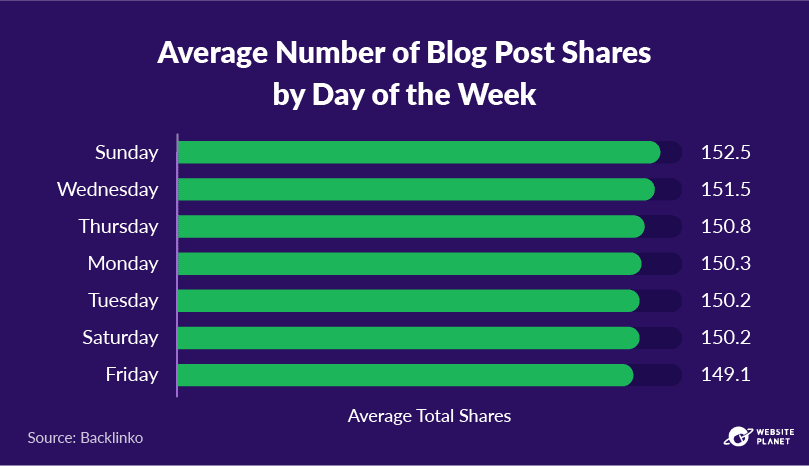 Research from Backlinko shows that, for blog posts, there is no “perfect day to post for blog posts at least.”
Blogs published on Sunday received the highest amount of social shares, yet Sunday posts still only gained 1.45% more shares compared to content posted in the other 6 days of the week.
What does this tell us? Backlino’s data suggests that the “best day to post” will likely be different for every blog, with similar results across the board.
Different audiences will be engaging with content on different days of the week. Across social media platforms, the most engaging days will change too.
Blogs should conduct their own research to find out when is best for them. This is the most meticulous way to perfect your blog’s posting schedule.
Research from Backlinko shows that, for blog posts, there is no “perfect day to post for blog posts at least.”
Blogs published on Sunday received the highest amount of social shares, yet Sunday posts still only gained 1.45% more shares compared to content posted in the other 6 days of the week.
What does this tell us? Backlino’s data suggests that the “best day to post” will likely be different for every blog, with similar results across the board.
Different audiences will be engaging with content on different days of the week. Across social media platforms, the most engaging days will change too.
Blogs should conduct their own research to find out when is best for them. This is the most meticulous way to perfect your blog’s posting schedule.
57. Post Frequently
 Publishing regularly enhances the performance of blogs. Bloggers should try to post more than 16 articles every month as this will see the best results.
Blogs that post 16 times per month get more traffic and leads than blogs that publish 0-4 times monthly.
Producing content consistently is therefore crucial. Regular content gives viewers a reason to stick around and follow your site more closely, and it provides more value to viewers with a larger pool of content to browse.
More quality content also means bloggers can gather more backlinks and rank higher on search engines. 82% of marketers who blog consistently see positive ROI from backlinks and boost search engine rankings (State of Inbound).
Publishing regularly enhances the performance of blogs. Bloggers should try to post more than 16 articles every month as this will see the best results.
Blogs that post 16 times per month get more traffic and leads than blogs that publish 0-4 times monthly.
Producing content consistently is therefore crucial. Regular content gives viewers a reason to stick around and follow your site more closely, and it provides more value to viewers with a larger pool of content to browse.
More quality content also means bloggers can gather more backlinks and rank higher on search engines. 82% of marketers who blog consistently see positive ROI from backlinks and boost search engine rankings (State of Inbound).
58. Big Blogs Boost Leads
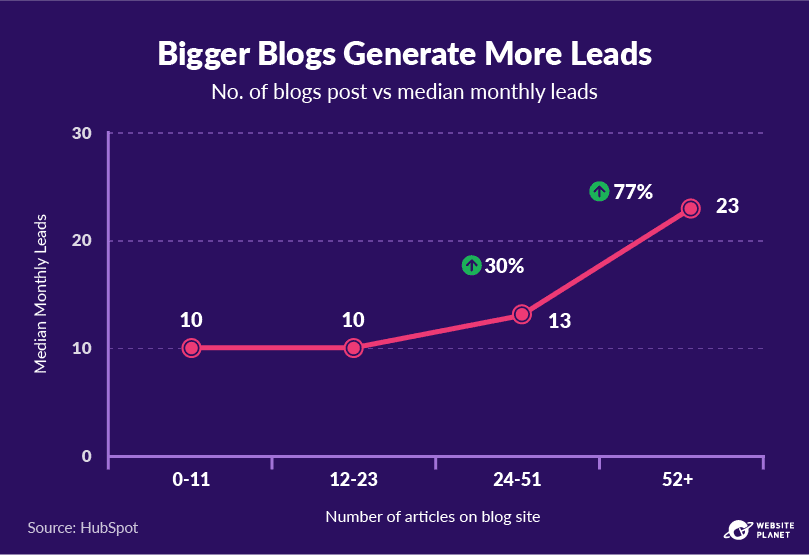 Producing frequent content will mean your site can build up a catalog of great blog posts. This can have a positive knock-on effect further down the line.
Producing a shedload of blog posts will bump lead generation after a few months of hard work. Blogs with more than 52 articles receive 77% more leads than smaller blogs.
That’s because you’re adding more pages to search engine results every time you post. HubSpot also found that increasing your site’s indexed pages above 311 boosts lead generation by 236%, so there’s a direct link between the two.
Producing frequent content will mean your site can build up a catalog of great blog posts. This can have a positive knock-on effect further down the line.
Producing a shedload of blog posts will bump lead generation after a few months of hard work. Blogs with more than 52 articles receive 77% more leads than smaller blogs.
That’s because you’re adding more pages to search engine results every time you post. HubSpot also found that increasing your site’s indexed pages above 311 boosts lead generation by 236%, so there’s a direct link between the two.
59. Top Blogs Have Common Traits
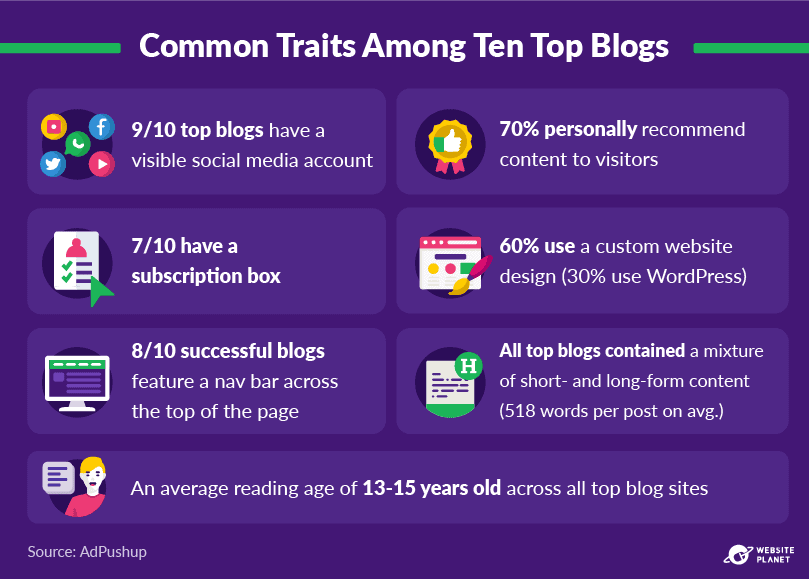 AdPushup analyzed 10 of the biggest blogs on the internet, from the Huffington Post to Perez Hilton, to find their defining traits.
Almost every top-performing blog features social media counts and above-the-fold nav bars. 70% use a subscription box, too.
60% of top sites are custom-made by web designers, while another 30% of top blogs use the WordPress content management platform. This shows that you can still build a great site with CM platforms, though many top blogs prefer to go their own route.
There’s a diverse range of short and long articles within each site, equating to an average word count of 518 words per post across all 10 sites.
Generally, top-performing blogs use simple language when writing articles. The average reading age across top-performing blogs is 13-15 years old.
AdPushup analyzed 10 of the biggest blogs on the internet, from the Huffington Post to Perez Hilton, to find their defining traits.
Almost every top-performing blog features social media counts and above-the-fold nav bars. 70% use a subscription box, too.
60% of top sites are custom-made by web designers, while another 30% of top blogs use the WordPress content management platform. This shows that you can still build a great site with CM platforms, though many top blogs prefer to go their own route.
There’s a diverse range of short and long articles within each site, equating to an average word count of 518 words per post across all 10 sites.
Generally, top-performing blogs use simple language when writing articles. The average reading age across top-performing blogs is 13-15 years old.
60. Guest Posts Add More Credibility
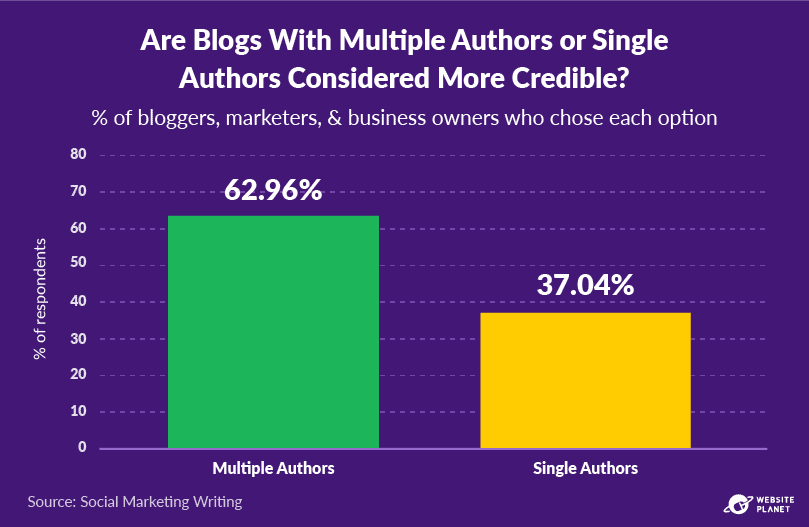 Guest posts help a site appear more trustworthy. By publishing guest posts, viewers do not hear from the same voice over and over again.
Having loads of different authors on a blog makes the site feel less like “one person’s opinion” and more like a team of qualified experts.
Guest posts bring a level of freshness to blogs by adding new perspectives. Despite the upsides of producing guest posts, they are still underused by the vast majority of bloggers. Just 6% of bloggers prioritize guest posts, and only 3% of bloggers publish more than 100 of them per month.
Guest posts help a site appear more trustworthy. By publishing guest posts, viewers do not hear from the same voice over and over again.
Having loads of different authors on a blog makes the site feel less like “one person’s opinion” and more like a team of qualified experts.
Guest posts bring a level of freshness to blogs by adding new perspectives. Despite the upsides of producing guest posts, they are still underused by the vast majority of bloggers. Just 6% of bloggers prioritize guest posts, and only 3% of bloggers publish more than 100 of them per month.
61. Custom Content Shows You Care
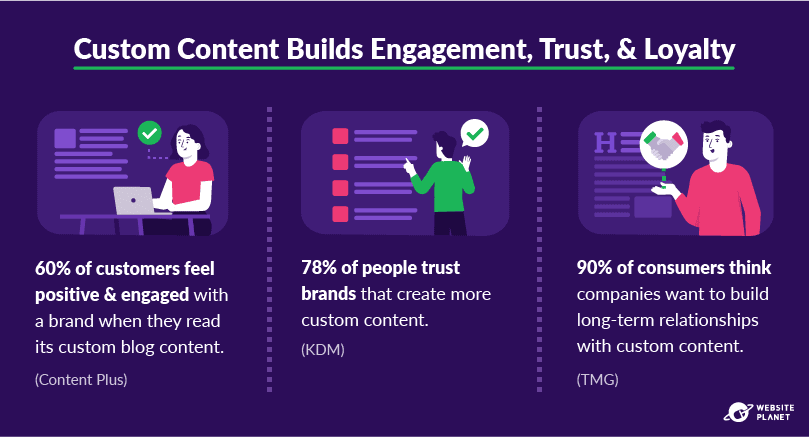 Custom content increases engagement, loyalty, and trust amongst existing customers. It’s content that is designed to suit a blog’s existing audience.
You might think, “Isn’t that what I’ve been doing this whole time?” but stay with me here.
You can think of content marketing as a method that is outward-facing. Much of your blog content probably targets new visitors if you’re a niche blogger, too.
Custom content is solely designed with the interests of your existing reader-base in mind. Catering to this audience will see positive results over time, a reason 78% of CMO’s think custom content will become the future of marketing (Demand Metric).
Custom content increases engagement, loyalty, and trust amongst existing customers. It’s content that is designed to suit a blog’s existing audience.
You might think, “Isn’t that what I’ve been doing this whole time?” but stay with me here.
You can think of content marketing as a method that is outward-facing. Much of your blog content probably targets new visitors if you’re a niche blogger, too.
Custom content is solely designed with the interests of your existing reader-base in mind. Catering to this audience will see positive results over time, a reason 78% of CMO’s think custom content will become the future of marketing (Demand Metric).
62. Add a Personalized Popover
 You can use personalized messages to provoke action from visitors. Targeted popups work for basically any blog, whether it’s an industry blog or a niche blog.
Even something as simple as a name on a call-to-action (CTA) will get results. Bloggers would have to invest in AI personalization systems, which can be expensive, but are totally worth it for big blogs that want to grow even bigger.
Bloggers can personalize content too. This is called “dynamic content.” Content can be changed based on the user to be more relevant. Even something as simple as geolocation can craft content and recommendations.
Personalized content promotes action: 78% of internet users say their purchasing intent increased through personally relevant content (OneSpot).
You can use personalized messages to provoke action from visitors. Targeted popups work for basically any blog, whether it’s an industry blog or a niche blog.
Even something as simple as a name on a call-to-action (CTA) will get results. Bloggers would have to invest in AI personalization systems, which can be expensive, but are totally worth it for big blogs that want to grow even bigger.
Bloggers can personalize content too. This is called “dynamic content.” Content can be changed based on the user to be more relevant. Even something as simple as geolocation can craft content and recommendations.
Personalized content promotes action: 78% of internet users say their purchasing intent increased through personally relevant content (OneSpot).
63. Repurpose Your Content
 Marketers, editors, and bloggers should repurpose content if they aren’t doing so already.
A lot of them are, as a matter of fact; 85% of the best marketers repurpose blog content, 29% have a repurposing strategy. 6/10 marketers will repurpose the same piece of blog content between 2-5 times (Curata).
Repurposing content allows you to drive more engagement and traffic without conducting another lengthy round of research. Bloggers might repurpose a blog post into an accompanying video, for example, or use a portion of the research to write an entirely different blog post.
Reusing existing content increases efficiency and boosts results. That’s why so many people do it.
Marketers, editors, and bloggers should repurpose content if they aren’t doing so already.
A lot of them are, as a matter of fact; 85% of the best marketers repurpose blog content, 29% have a repurposing strategy. 6/10 marketers will repurpose the same piece of blog content between 2-5 times (Curata).
Repurposing content allows you to drive more engagement and traffic without conducting another lengthy round of research. Bloggers might repurpose a blog post into an accompanying video, for example, or use a portion of the research to write an entirely different blog post.
Reusing existing content increases efficiency and boosts results. That’s why so many people do it.
64. Update Your Content
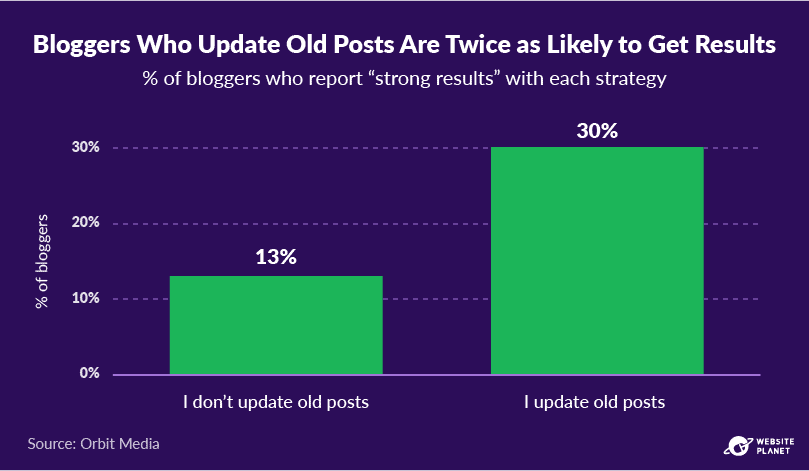 Updating content is another normality amongst bloggers, a tactic employed by 70% of them in 2020.
That’s because updating content is easy and effective; your old posts achieve nothing if their content is stale!
Old content could even damage your site’s SEO, with its lack of relevancy damaging the credibility and value a blog can offer.
Updating content not only delivers results. It’s an essential piece of housekeeping that maintains the performance of a blog.
Updating content is another normality amongst bloggers, a tactic employed by 70% of them in 2020.
That’s because updating content is easy and effective; your old posts achieve nothing if their content is stale!
Old content could even damage your site’s SEO, with its lack of relevancy damaging the credibility and value a blog can offer.
Updating content not only delivers results. It’s an essential piece of housekeeping that maintains the performance of a blog.
65. Curate Content
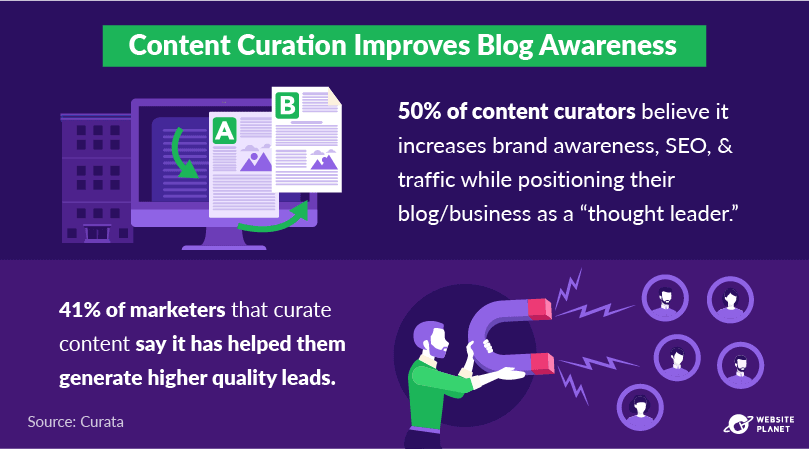 Content curation is the process of sorting and sharing other peoples’ research through marketing channels. Normally, curators share through social media channels or email.
This is not stealing others’ content. Rather, content curation provides a link to other resources that a blog’s audience might find interesting.
This is particularly useful to marketers, which is why 82% of them curate content (IMN). Not only does this keep the content calendar full with minimal effort, but it also positions a brand as a thought leader.
Content curation provides a constant source of value to readers, which is why it improves a business’ lead generation.
Content curation is the process of sorting and sharing other peoples’ research through marketing channels. Normally, curators share through social media channels or email.
This is not stealing others’ content. Rather, content curation provides a link to other resources that a blog’s audience might find interesting.
This is particularly useful to marketers, which is why 82% of them curate content (IMN). Not only does this keep the content calendar full with minimal effort, but it also positions a brand as a thought leader.
Content curation provides a constant source of value to readers, which is why it improves a business’ lead generation.
66. Do Bloggers Use An Editor?
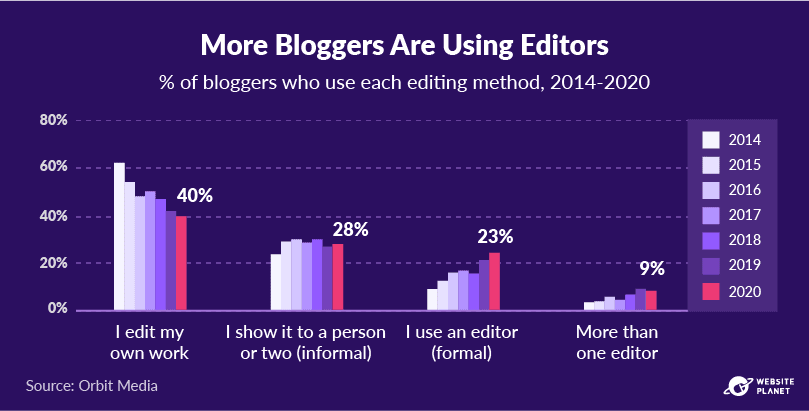 More bloggers are using an editor today than ever before. In 2014, just 1 in 10 bloggers used a formal editor. In 2020, that figure had risen to 1 in 3 bloggers.
More bloggers are using an editor as they realize just how crucial it is. Checking work informally (or by yourself) just isn’t as effective, no matter how good you are at writing.
Invariably, there will always be mistakes that writers miss. That’s why 72% of bloggers who get “strong results” use one or more editors. 38% of top bloggers use at least 2 editors.
To put that into perspective, just 22% of bloggers who don’t have an editor report “strong results.”
More bloggers are using an editor today than ever before. In 2014, just 1 in 10 bloggers used a formal editor. In 2020, that figure had risen to 1 in 3 bloggers.
More bloggers are using an editor as they realize just how crucial it is. Checking work informally (or by yourself) just isn’t as effective, no matter how good you are at writing.
Invariably, there will always be mistakes that writers miss. That’s why 72% of bloggers who get “strong results” use one or more editors. 38% of top bloggers use at least 2 editors.
To put that into perspective, just 22% of bloggers who don’t have an editor report “strong results.”
67. How Do Bloggers Decide on a Topic?
 In the initial stages of a new post, where do bloggers go to find inspiration?
The very best bloggers do indeed look for inspiration. 71% of badly-performing bloggers say they simply rely on their judgment, whereas just 37% of top-performing bloggers claim to have done the same.
Social media and keyword research are the 2 places that top bloggers go for inspiration. 68% of high-earning bloggers research topics on social media sites, while 64% base their topics on the best keywords they can find.
In the initial stages of a new post, where do bloggers go to find inspiration?
The very best bloggers do indeed look for inspiration. 71% of badly-performing bloggers say they simply rely on their judgment, whereas just 37% of top-performing bloggers claim to have done the same.
Social media and keyword research are the 2 places that top bloggers go for inspiration. 68% of high-earning bloggers research topics on social media sites, while 64% base their topics on the best keywords they can find.
68. Success Metrics
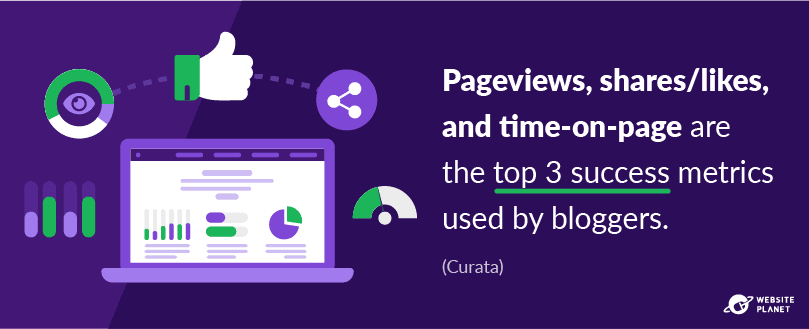 Traffic, engagement, and time-on-site are the measurable values by which bloggers judge their success.
Of course, marketers will scrutinize ROI statistics, such as leads, conversions, and sales. But the metrics mentioned above are a one-size-fits-all sign of success, whatever the purpose of your blog.
Traffic, engagement, and time-on-site are the measurable values by which bloggers judge their success.
Of course, marketers will scrutinize ROI statistics, such as leads, conversions, and sales. But the metrics mentioned above are a one-size-fits-all sign of success, whatever the purpose of your blog.
69. High-Income Bloggers Outsource Well
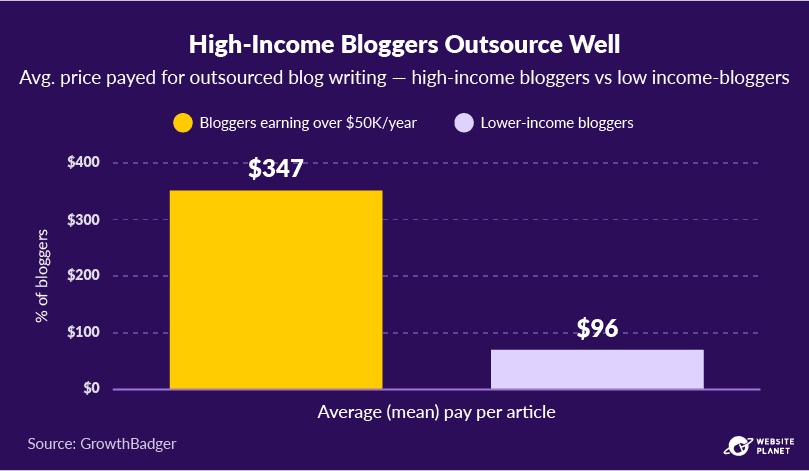 Almost every blogger and marketer has to outsource content creation from time to time. Content marketing leaders outsource 24% of their blog writing on average (Curata).
Bloggers may outsource work because they’ve got an abundance of in-demand content or because their content writer is flooded with projects. Outsourcing also provides fresh perspectives (like guest posts), so there are other benefits too.
The best bloggers pay 3.6X more for outsourced content. Top bloggers pay well for content, ensuring they will get high-quality blog pieces for their money.
Almost every blogger and marketer has to outsource content creation from time to time. Content marketing leaders outsource 24% of their blog writing on average (Curata).
Bloggers may outsource work because they’ve got an abundance of in-demand content or because their content writer is flooded with projects. Outsourcing also provides fresh perspectives (like guest posts), so there are other benefits too.
The best bloggers pay 3.6X more for outsourced content. Top bloggers pay well for content, ensuring they will get high-quality blog pieces for their money.
70. What Other Content Types Do Bloggers Use?
 High-income bloggers diversify their content far more often than poorly-performing blogs.
This means that the very best bloggers are not simply churning out blog post after blog post. Instead, they are crafting a selection of different forms of content to accompany their articles.
Non-live video is the most popular type of content amongst top bloggers, 42% of which produce static video. What’s more, this group produces static video 4.5X more often than low-income bloggers.
26% of top bloggers utilize live video, as opposed to 5% of low-income bloggers. Top bloggers are 5.8X more likely to post case studies as well.
High-income bloggers diversify their content far more often than poorly-performing blogs.
This means that the very best bloggers are not simply churning out blog post after blog post. Instead, they are crafting a selection of different forms of content to accompany their articles.
Non-live video is the most popular type of content amongst top bloggers, 42% of which produce static video. What’s more, this group produces static video 4.5X more often than low-income bloggers.
26% of top bloggers utilize live video, as opposed to 5% of low-income bloggers. Top bloggers are 5.8X more likely to post case studies as well.
71. Blogging Challenges
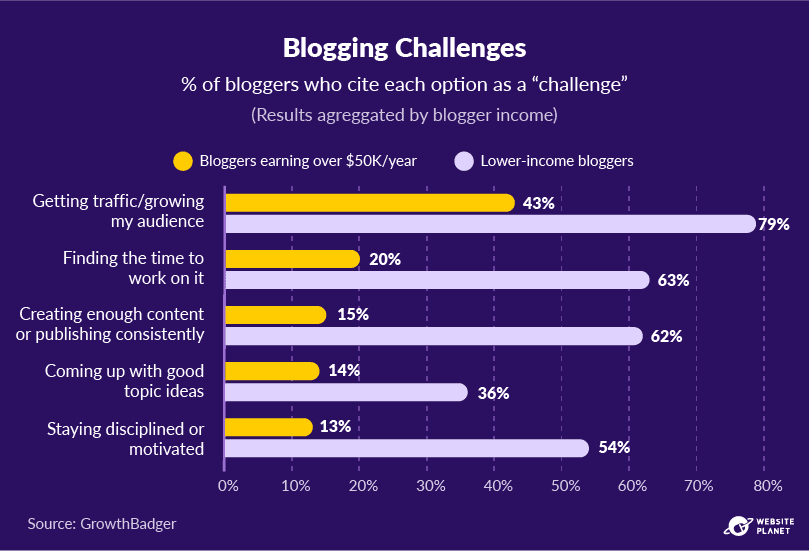 No one said blogging was easy. There are some common difficulties amongst bloggers who are earning less money than others.
Traffic growth, a key goal for any blogger, is a challenge for 79% of low-income bloggers.
Finding enough time is another challenge, while creating content consistently is difficult for 62% of low-income bloggers.
No one said blogging was easy. There are some common difficulties amongst bloggers who are earning less money than others.
Traffic growth, a key goal for any blogger, is a challenge for 79% of low-income bloggers.
Finding enough time is another challenge, while creating content consistently is difficult for 62% of low-income bloggers.
The Best Blogging Platforms
In section 6, we’re taking a look at blogging platforms and website statistics. In particular, which content management platforms are the biggest? And what do you need to do to make sure your site performs the best?72. Blogging Market Share
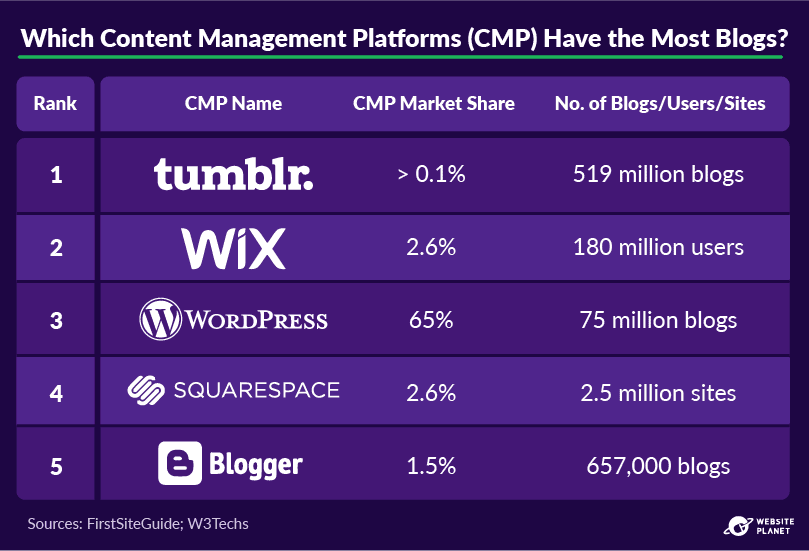 The biggest content management platforms are not always the biggest platforms for blog sites.
This is backed up by the data; take WordPress, for example. WordPress is the biggest content management platform (CMP), powering over 40% of the internet, yet Tumblr is home to 5 times more blog sites than WordPress.
Tumblr is by far the biggest CMP for bloggers. Tumblr hosts well over 500 million blogs in 2021, and this number is only going up.
WordPress is still a hugely popular place for bloggers. 70 million blog posts are published on WordPress sites every month, along with 77 million comments.
Together, just 409 million WordPress users read more than 20 billion pages every month. That’s impressive.
The biggest content management platforms are not always the biggest platforms for blog sites.
This is backed up by the data; take WordPress, for example. WordPress is the biggest content management platform (CMP), powering over 40% of the internet, yet Tumblr is home to 5 times more blog sites than WordPress.
Tumblr is by far the biggest CMP for bloggers. Tumblr hosts well over 500 million blogs in 2021, and this number is only going up.
WordPress is still a hugely popular place for bloggers. 70 million blog posts are published on WordPress sites every month, along with 77 million comments.
Together, just 409 million WordPress users read more than 20 billion pages every month. That’s impressive.
73. Top WordPress Plugins
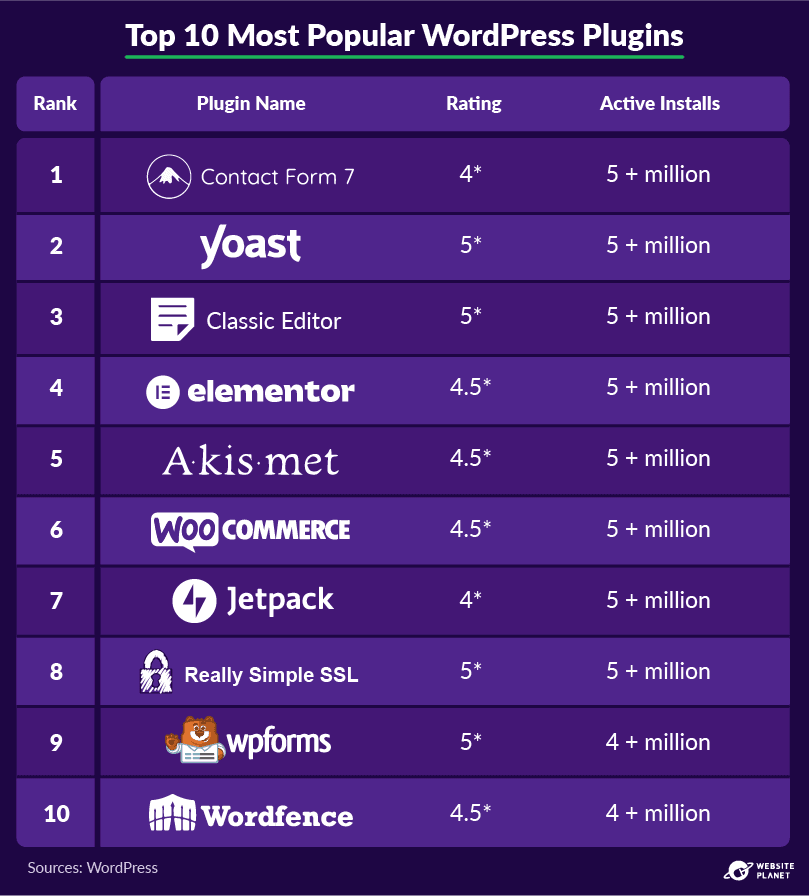 A quick look at WordPress’s “most popular” page shows us the 10 best WordPress plugins, based on active downloads and user satisfaction.
ContactForm 7 and YoastSEO are the 2 biggest WordPress plugins. YoastSEO helps users optimize their website, giving bloggers the tools to reach the best SEO and readability standards.
Elementor is another important plugin that helps users build better-looking websites, which is essential to attract new visitors to your blog.
A quick look at WordPress’s “most popular” page shows us the 10 best WordPress plugins, based on active downloads and user satisfaction.
ContactForm 7 and YoastSEO are the 2 biggest WordPress plugins. YoastSEO helps users optimize their website, giving bloggers the tools to reach the best SEO and readability standards.
Elementor is another important plugin that helps users build better-looking websites, which is essential to attract new visitors to your blog.
74. WordPress Languages
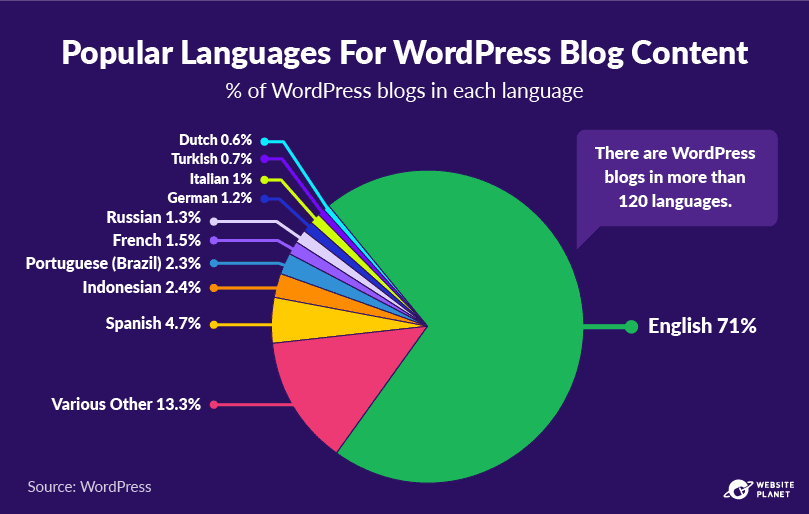 Blogs on WordPress are written in all kinds of different languages, but, without a doubt, English is the dominant language.
In fact, over 60% of all websites are written in English, so it helps to accommodate English speakers in your content, especially when you consider that the top 2 blogging countries are English-speaking (the U.S. & the U.K.).
There are other languages on WordPress, with 4.7% of WP blogs written in Spanish. That means there are still opportunities to target other languages and nationalities with your content.
Blogs on WordPress are written in all kinds of different languages, but, without a doubt, English is the dominant language.
In fact, over 60% of all websites are written in English, so it helps to accommodate English speakers in your content, especially when you consider that the top 2 blogging countries are English-speaking (the U.S. & the U.K.).
There are other languages on WordPress, with 4.7% of WP blogs written in Spanish. That means there are still opportunities to target other languages and nationalities with your content.
75. Tumblr Users Are Younger
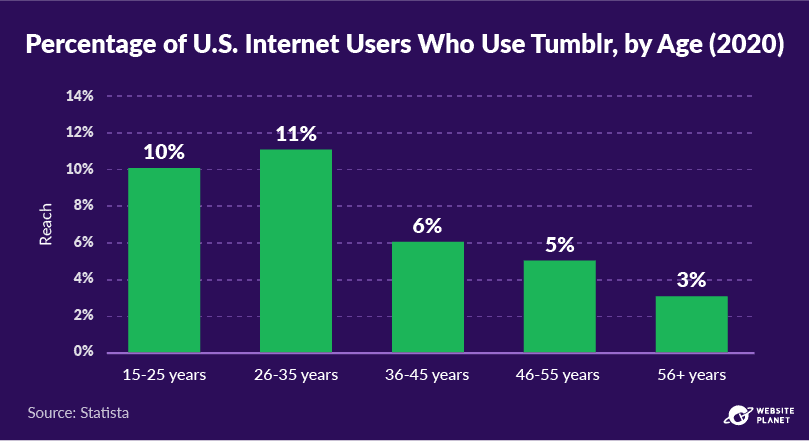 Tumblr users are generally quite young. As a microblogging social network, you should consider this when setting up a blog on the platform.
69% of all users on Tumblr are millennials (Comscore). In the above graphic, we can see that most U.S. Tumblr users are under the age of 35.
The U.S. accounts for 33.2% of Tumblr users, so catering to this audience should see results. Bloggers on Tumblr could choose topics that appeal to younger viewers or simply target a smaller age group with the right niche.
Tumblr users are generally quite young. As a microblogging social network, you should consider this when setting up a blog on the platform.
69% of all users on Tumblr are millennials (Comscore). In the above graphic, we can see that most U.S. Tumblr users are under the age of 35.
The U.S. accounts for 33.2% of Tumblr users, so catering to this audience should see results. Bloggers on Tumblr could choose topics that appeal to younger viewers or simply target a smaller age group with the right niche.
76. Blog Performance Tactics
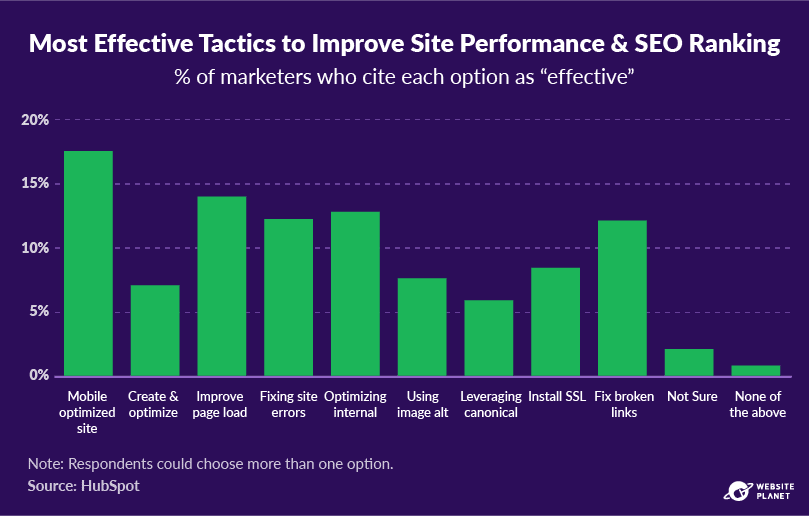 What are the best ways to drive more traffic to your site? And I’m not talking about marketing tactics here…
The word “optimize” pops up frequently. That’s because improving the optimization of different aspects of your site will improve your ranking on search engines (search engine optimization). In turn, this brings in more traffic.
Generally, improving the user’s experience of your site is going to boost the site’s ranking. Optimizing the site for mobile users will significantly affect SEO while improving loading times and fixing errors are also crucial factors.
What are the best ways to drive more traffic to your site? And I’m not talking about marketing tactics here…
The word “optimize” pops up frequently. That’s because improving the optimization of different aspects of your site will improve your ranking on search engines (search engine optimization). In turn, this brings in more traffic.
Generally, improving the user’s experience of your site is going to boost the site’s ranking. Optimizing the site for mobile users will significantly affect SEO while improving loading times and fixing errors are also crucial factors.
77. Site Load Time Is Important
 “Bounce rate” is the rate at which users ditch your site after viewing (or loading) one page.
Bounce rates increase exponentially as a site takes longer to load, which outlines the need for a load-time optimized site.
53% of visitors will leave your site should it fail to load in less than 7 seconds. After 10 seconds, a slow-loading site has lost 65% of visitors. That’s 65% of your potential leads or monetizable ad viewers!
“Bounce rate” is the rate at which users ditch your site after viewing (or loading) one page.
Bounce rates increase exponentially as a site takes longer to load, which outlines the need for a load-time optimized site.
53% of visitors will leave your site should it fail to load in less than 7 seconds. After 10 seconds, a slow-loading site has lost 65% of visitors. That’s 65% of your potential leads or monetizable ad viewers!
78. Poor Web Design is Unprofessional
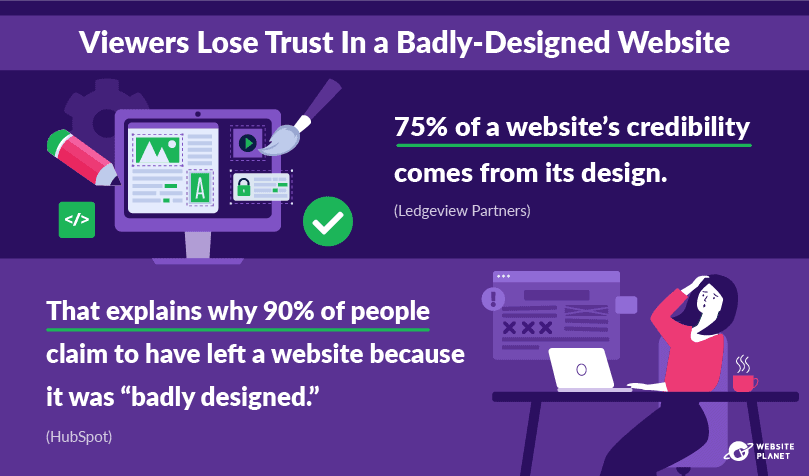 Bloggers should spend a lot of time making sure their website is attractive. Viewers lose trust in a website that looks bad, and they’ll leave as a result.
Using design-centric plugins should help, and choosing a consistent color scheme is another essential part of web design. This is going to help you target your niche and keep the aesthetic of your site looking clean.
Bloggers should spend a lot of time making sure their website is attractive. Viewers lose trust in a website that looks bad, and they’ll leave as a result.
Using design-centric plugins should help, and choosing a consistent color scheme is another essential part of web design. This is going to help you target your niche and keep the aesthetic of your site looking clean.
The Best Blogging Techniques
In this section, we’ll take a look at some of the best blogging techniques. You need to keep this stuff in mind when writing the blog itself — all backed up by cold-hard facts, of course.79. Top Ranking Content is (Kind of) Long
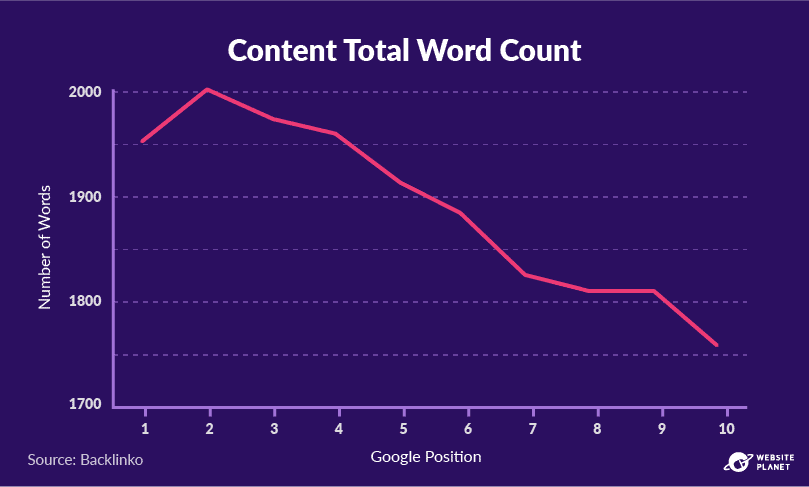 Content between 1750 and 2000 words long is the most common length for Google’s top 10 results.
Many people would consider these long-form articles, though some bloggers write 7000+ word pieces, so they’re not quite long reads.
Backlinko’s data shows the sweet spot for ranking on Google’s first page is around 2000 words long.
Even though people usually prefer to read shorter articles, 75% of internet users prefer blogs under 1,000 words long (Semrush).
Nonetheless, longer content has better SEO performance because it provides more information. That’s why longer blogs receive more backlinks…
Content between 1750 and 2000 words long is the most common length for Google’s top 10 results.
Many people would consider these long-form articles, though some bloggers write 7000+ word pieces, so they’re not quite long reads.
Backlinko’s data shows the sweet spot for ranking on Google’s first page is around 2000 words long.
Even though people usually prefer to read shorter articles, 75% of internet users prefer blogs under 1,000 words long (Semrush).
Nonetheless, longer content has better SEO performance because it provides more information. That’s why longer blogs receive more backlinks…
80. Long Posts Get More Backlinks
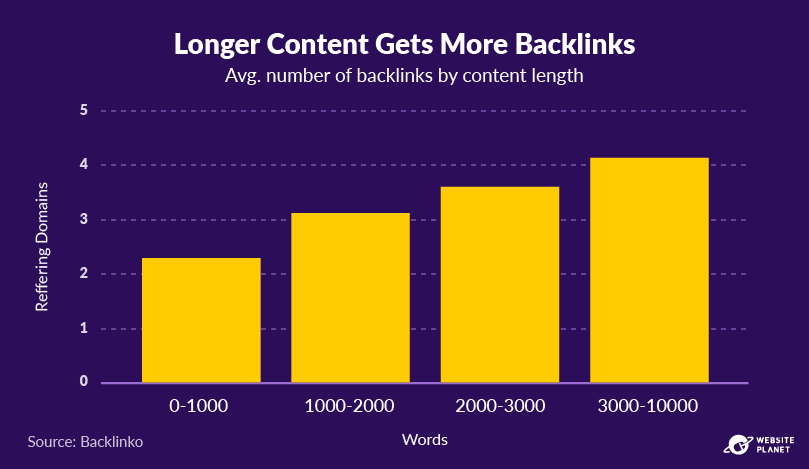 94% of blog pieces don’t get a single backlink. That’s kind of sad, but there is one way to combat this issue: long-form content!
Super-long blog posts (like the one you’re reading) receive the most backlinks. This makes sense. When you provide loads of information, readers are more likely to find something useful in your post — and they’re more likely to credit you for that information at a later date.
That means writing longer content will improve your site’s ability to rank on Google.
94% of blog pieces don’t get a single backlink. That’s kind of sad, but there is one way to combat this issue: long-form content!
Super-long blog posts (like the one you’re reading) receive the most backlinks. This makes sense. When you provide loads of information, readers are more likely to find something useful in your post — and they’re more likely to credit you for that information at a later date.
That means writing longer content will improve your site’s ability to rank on Google.
81. Longreads Perform Best
 Semrush found that content length has a direct effect on traffic. The longer the article, the more unique visitors it receives, with articles over 7000+ words long getting the best traffic.
Longreads received the best shares in Semrush’s study (30). The 1501-2000 word category was a close second for shares with 28.
Long content is beneficial, then, both to bloggers and readers. That’s why top bloggers are posting more long-form content than others. The average post length for a high-income blogger is 2,424 words (GrowthBadger). That’s some 83% longer than the average post for low-income bloggers!
Semrush found that content length has a direct effect on traffic. The longer the article, the more unique visitors it receives, with articles over 7000+ words long getting the best traffic.
Longreads received the best shares in Semrush’s study (30). The 1501-2000 word category was a close second for shares with 28.
Long content is beneficial, then, both to bloggers and readers. That’s why top bloggers are posting more long-form content than others. The average post length for a high-income blogger is 2,424 words (GrowthBadger). That’s some 83% longer than the average post for low-income bloggers!
82. Create Skimmable Content
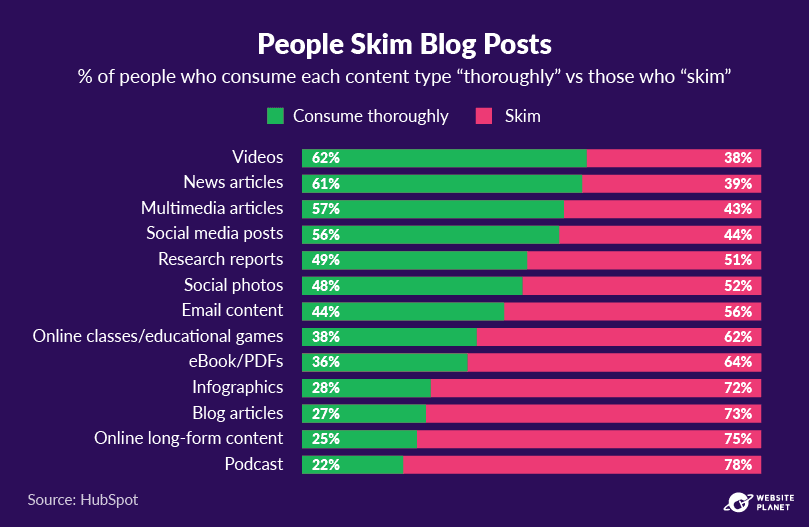 So, we’ve decided on a good length for content. 1700-2000 words if you’re going for Google’s first page, longer forms for overall performance. Now there are a few more things for bloggers to consider before they start writing.
To be a successful blogger, one must understand the behavior of the average blog reader.
People have very short attention spans in 2021, so creating “skimmable” content is crucial.
By that, I mean: “create content that is easy to skim through.” And by that, I mean: “use simple language, don’t write huge blocks of text, use lists, and break up text with images.” Sounds fairly straightforward.
Achieving such an effect will have positive outcomes, particularly for B2B marketers. Most of which commit just 5-10 minutes to read a blog, so make sure the best bits of information are accessible!
So, we’ve decided on a good length for content. 1700-2000 words if you’re going for Google’s first page, longer forms for overall performance. Now there are a few more things for bloggers to consider before they start writing.
To be a successful blogger, one must understand the behavior of the average blog reader.
People have very short attention spans in 2021, so creating “skimmable” content is crucial.
By that, I mean: “create content that is easy to skim through.” And by that, I mean: “use simple language, don’t write huge blocks of text, use lists, and break up text with images.” Sounds fairly straightforward.
Achieving such an effect will have positive outcomes, particularly for B2B marketers. Most of which commit just 5-10 minutes to read a blog, so make sure the best bits of information are accessible!
83. Blog Quality Is Essential
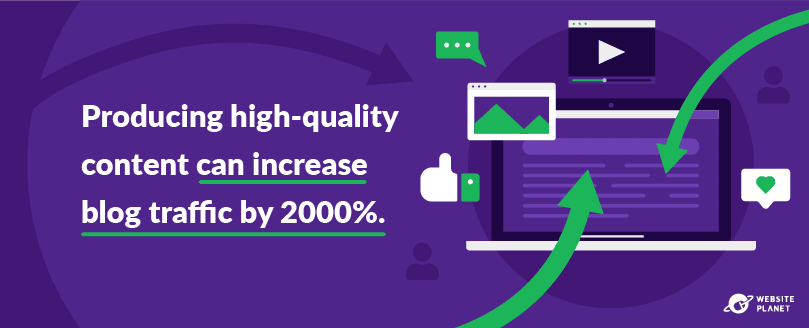 Bloggers rate quality content as the number one most important factor for blogging success in a GrowthBadger survey.
Undoubtedly, content quality makes the difference between a successful blog post and a dud.
This shift towards higher quality (and longer) forms of content explains why bloggers are now spending 63% more time on posts than they were six years ago (Orbit Media).
Not only will focusing on quality content produce tangible results, but failing to do so will hurt your blog. 23.84% of blog readers believe bad quality content damages a site’s credibility.
Quality content starts with quality research. 32% of blog readers say that content accuracy is one of the most crucial factors in content quality. In other words, use reputable sources and up-to-date studies. That should do the trick.
Bloggers rate quality content as the number one most important factor for blogging success in a GrowthBadger survey.
Undoubtedly, content quality makes the difference between a successful blog post and a dud.
This shift towards higher quality (and longer) forms of content explains why bloggers are now spending 63% more time on posts than they were six years ago (Orbit Media).
Not only will focusing on quality content produce tangible results, but failing to do so will hurt your blog. 23.84% of blog readers believe bad quality content damages a site’s credibility.
Quality content starts with quality research. 32% of blog readers say that content accuracy is one of the most crucial factors in content quality. In other words, use reputable sources and up-to-date studies. That should do the trick.
84. Back Content With Facts
 While we’re on the topic of quality research, make sure you back up what you’re saying with facts. People aren’t just going to take your word for it.
Adding statistics and data will solidify any claims you make throughout the blog post. Without stats, your blog becomes an opinion piece — and this isn’t always useful for an informative blog post.
Unless, of course, you’ve built enough credit to be known universally as an expert in your given field.
While we’re on the topic of quality research, make sure you back up what you’re saying with facts. People aren’t just going to take your word for it.
Adding statistics and data will solidify any claims you make throughout the blog post. Without stats, your blog becomes an opinion piece — and this isn’t always useful for an informative blog post.
Unless, of course, you’ve built enough credit to be known universally as an expert in your given field.
85. Use Original Research
 More bloggers are using original research than ever before, and these people are more likely to get fantastic results from their content.
Original research is research that a blogger conducts themselves. That doesn’t mean cherry-picking the best pieces of information from other sources; original researchers start from scratch.
A piece of original research might be a survey you conducted yourself, or your own analysis of a specific topic. Whatever route bloggers take, they’re sure to get great results. Original research positions you as an authority in a given area.
It will also receive a shedload of backlinks, especially if it’s a topic with a scarcity of current resources.
Original research is beneficial for building brand credibility, which is why 81% of marketers plan to increase their use of originally researched blog posts in the future (Social Media Examiner).
More bloggers are using original research than ever before, and these people are more likely to get fantastic results from their content.
Original research is research that a blogger conducts themselves. That doesn’t mean cherry-picking the best pieces of information from other sources; original researchers start from scratch.
A piece of original research might be a survey you conducted yourself, or your own analysis of a specific topic. Whatever route bloggers take, they’re sure to get great results. Original research positions you as an authority in a given area.
It will also receive a shedload of backlinks, especially if it’s a topic with a scarcity of current resources.
Original research is beneficial for building brand credibility, which is why 81% of marketers plan to increase their use of originally researched blog posts in the future (Social Media Examiner).
86. The Best Performing Headline Types
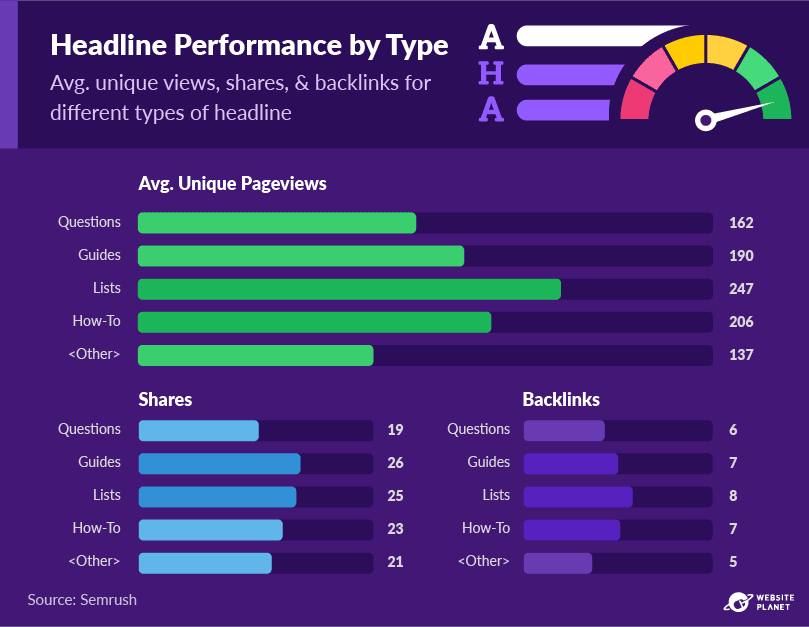 We’ve touched on the popularity of listicles, so it makes sense that listicle headlines perform the best. Across all industries and niches, listicle headlines get 80% more page views compared to other headline types. They also rank highest for backlinks.
Listicles receive the second most shares as well, and this performance is backed by other studies. ConversionXL found that people prefer list-based headlines over any other type of headline.
Question headlines, how-to, and guide headlines are the other major players. How-tos are comparable to listicles across all 3 metrics, while guide headlines receive the most social shares.
P.S. If you’re going to write a listicle, stick an odd number in the title. Odd-numbered list-based headlines outperform even-numbered listicle titles by 20%.
We’ve touched on the popularity of listicles, so it makes sense that listicle headlines perform the best. Across all industries and niches, listicle headlines get 80% more page views compared to other headline types. They also rank highest for backlinks.
Listicles receive the second most shares as well, and this performance is backed by other studies. ConversionXL found that people prefer list-based headlines over any other type of headline.
Question headlines, how-to, and guide headlines are the other major players. How-tos are comparable to listicles across all 3 metrics, while guide headlines receive the most social shares.
P.S. If you’re going to write a listicle, stick an odd number in the title. Odd-numbered list-based headlines outperform even-numbered listicle titles by 20%.
87. Longer Listicles Perform Better
 While we’re on the topic of listicles, make sure you add at least one list to your article somewhere. People love this simplified way of presenting information.
People love lists so much that adding just 1 list every 500 words can increase a post’s traffic by 70%.
If shares are what you’re after, then more lists (or longer listicles) should deliver the best results. Meanwhile, posts with 1 or 2 lists receive the most backlinks.
While we’re on the topic of listicles, make sure you add at least one list to your article somewhere. People love this simplified way of presenting information.
People love lists so much that adding just 1 list every 500 words can increase a post’s traffic by 70%.
If shares are what you’re after, then more lists (or longer listicles) should deliver the best results. Meanwhile, posts with 1 or 2 lists receive the most backlinks.
88. Question Headlines Are Popular
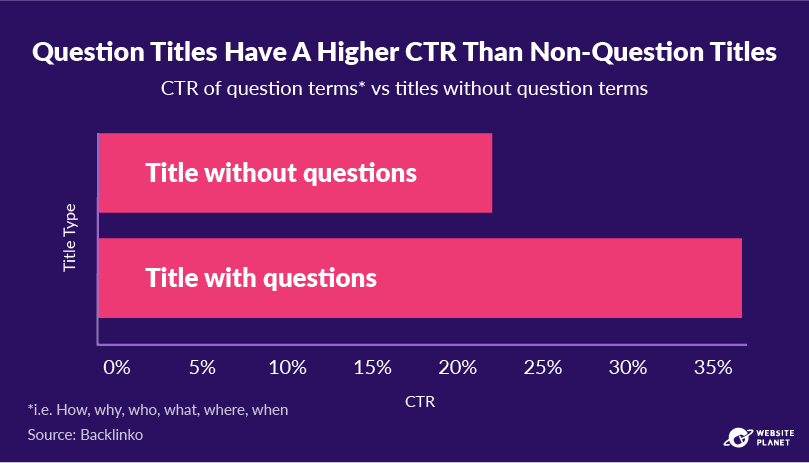 Don’t discount question headlines; H1s containing a question phrase have a way higher click-through rate than headlines without one.
Backlinko’s study discovered that question phrases (i.e., how, what, where) in a headline can bump CTR by a whopping 14.1%.
Make sure you don’t forget to add a question mark to the end of your question headline, either. The same study found that adding a “?” to your title will increase social shares by around 16%!
Don’t discount question headlines; H1s containing a question phrase have a way higher click-through rate than headlines without one.
Backlinko’s study discovered that question phrases (i.e., how, what, where) in a headline can bump CTR by a whopping 14.1%.
Make sure you don’t forget to add a question mark to the end of your question headline, either. The same study found that adding a “?” to your title will increase social shares by around 16%!
89. The Best Headline Length
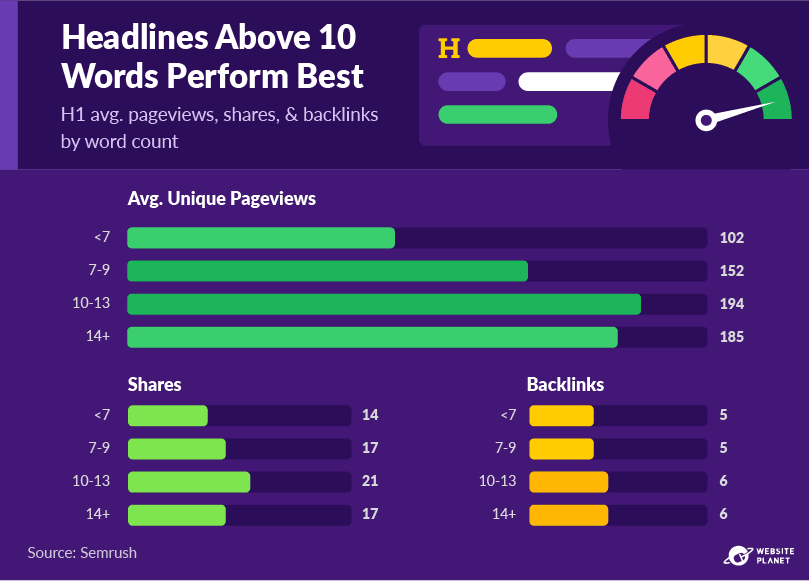 The length of your headline has a significant impact on performance.
On average, headlines between 10 and 13 words long receive twice as much traffic and 1.5X more shares than shorter headlines. Headlines over 14 words long get a great amount of traffic, too.
In general, longer headlines perform best. Backlinko’s study demonstrated the same trend, with longer headlines (14-17 words) receiving 77% more social shares than short headlines.
When it comes to writing your headline, make sure you add a hyphen or colon somewhere. A colon or hyphen in your headline can improve performance by 9%.
The length of your headline has a significant impact on performance.
On average, headlines between 10 and 13 words long receive twice as much traffic and 1.5X more shares than shorter headlines. Headlines over 14 words long get a great amount of traffic, too.
In general, longer headlines perform best. Backlinko’s study demonstrated the same trend, with longer headlines (14-17 words) receiving 77% more social shares than short headlines.
When it comes to writing your headline, make sure you add a hyphen or colon somewhere. A colon or hyphen in your headline can improve performance by 9%.
90. Draft Lots of Headlines
 One last headline-specific detail before we move into the next content element: draft a lot of headlines! Headlines are so important that you need to make sure you get this right.
Bloggers who draft more headlines get better results. In fact, bloggers who took the time to draft more than 20 different headline options were most likely to report “strong results.”
Finding the perfect headline will undoubtedly be worth your time. Editing your headline to get a better H1 can increase clicks by as much as 10%!
One last headline-specific detail before we move into the next content element: draft a lot of headlines! Headlines are so important that you need to make sure you get this right.
Bloggers who draft more headlines get better results. In fact, bloggers who took the time to draft more than 20 different headline options were most likely to report “strong results.”
Finding the perfect headline will undoubtedly be worth your time. Editing your headline to get a better H1 can increase clicks by as much as 10%!
91. How Do You Structure the Piece?
 The best posts often use a greater mix of different headings, while lower-performing posts generally have a less complex structure.
39% of low-performing posts don’t use another header outside the main title, compared to just 19% of the best-performing blog posts.
Medium-performing and top-performing blog posts both use H2s and H3s more frequently than low-performing posts. Top posts use the most wide-ranging mix of headers. Top posts use a mix of all header types 56% of the time, and this figure is significantly lower for medium-performing posts (27%) and low-performing posts (16%).
The best posts often use a greater mix of different headings, while lower-performing posts generally have a less complex structure.
39% of low-performing posts don’t use another header outside the main title, compared to just 19% of the best-performing blog posts.
Medium-performing and top-performing blog posts both use H2s and H3s more frequently than low-performing posts. Top posts use the most wide-ranging mix of headers. Top posts use a mix of all header types 56% of the time, and this figure is significantly lower for medium-performing posts (27%) and low-performing posts (16%).
92. Add (Lots of) Images
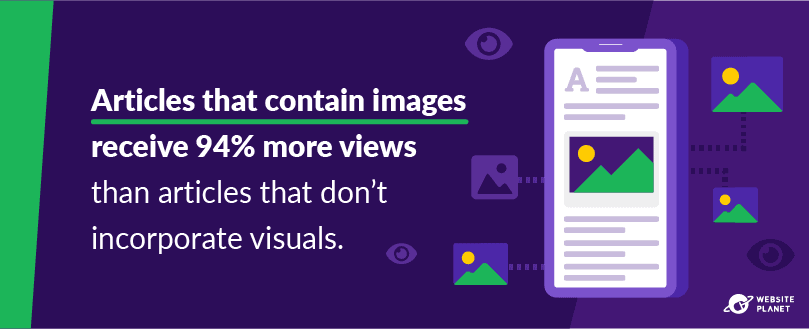 Images are crucial to blogging success, which is why content writers across the world universally use them. 90% of bloggers add images to their articles (Orbit Media).
Images work to break up sections of text, increasing the readability and engagement of a blog piece.
How many images should you add? The answer to that question may differ depending on the content of each article. In general, though, the more images you add, the better. Blog posts with an image every 75-100 words get twice as many shares as other blog posts.
Images are crucial to blogging success, which is why content writers across the world universally use them. 90% of bloggers add images to their articles (Orbit Media).
Images work to break up sections of text, increasing the readability and engagement of a blog piece.
How many images should you add? The answer to that question may differ depending on the content of each article. In general, though, the more images you add, the better. Blog posts with an image every 75-100 words get twice as many shares as other blog posts.
93. Original Images vs. Stock Images
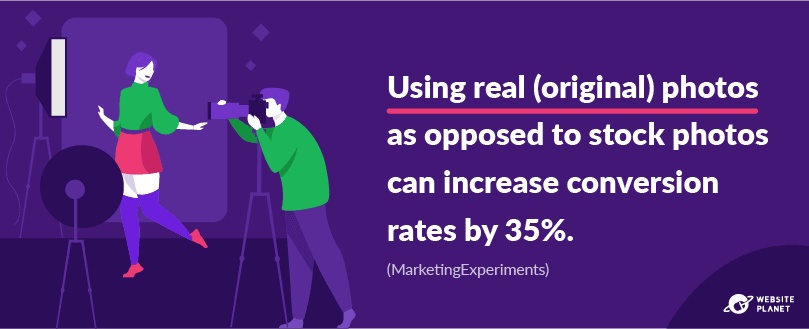 The originality of your images really matters. Adding original images increases blog performance, especially within a business blogging context.
Yet, 40% of marketers use stock images more than any other type of visual content (Venngage).
Why? Because stock photos are the path of least resistance. They’re instantly sourceable and require very little work, which cannot be said for original images.
Original images outperform stock images, however. A blog post with original imagery offers a more consistent, professional-looking experience than one with generic stock images.
Readers value the extra effort. That explains the improvement in conversions that brands can expect when they begin using original images.
The originality of your images really matters. Adding original images increases blog performance, especially within a business blogging context.
Yet, 40% of marketers use stock images more than any other type of visual content (Venngage).
Why? Because stock photos are the path of least resistance. They’re instantly sourceable and require very little work, which cannot be said for original images.
Original images outperform stock images, however. A blog post with original imagery offers a more consistent, professional-looking experience than one with generic stock images.
Readers value the extra effort. That explains the improvement in conversions that brands can expect when they begin using original images.
94. Infographics Make Blogs Better
 Infographics are another type of image that can improve engagement for your blog posts.
Infographics are a fantastic option for informative pieces, such as how-to articles or listicles. They present information alongside descriptive images, which increases readability.
This works because 65% of people are visual learners. It helps to “see” important pieces of information rather than read statements in black and white.
By boosting the readability of your post, people will remember the information presented to them in more detail, and they’ll follow any instructions with greater accuracy.
Posts with infographics draw people in, hold their attention, and then deliver value with greater success. That’s why infographics significantly increase a post’s social media shares.
Infographics are another type of image that can improve engagement for your blog posts.
Infographics are a fantastic option for informative pieces, such as how-to articles or listicles. They present information alongside descriptive images, which increases readability.
This works because 65% of people are visual learners. It helps to “see” important pieces of information rather than read statements in black and white.
By boosting the readability of your post, people will remember the information presented to them in more detail, and they’ll follow any instructions with greater accuracy.
Posts with infographics draw people in, hold their attention, and then deliver value with greater success. That’s why infographics significantly increase a post’s social media shares.
95. Videos Drive Results
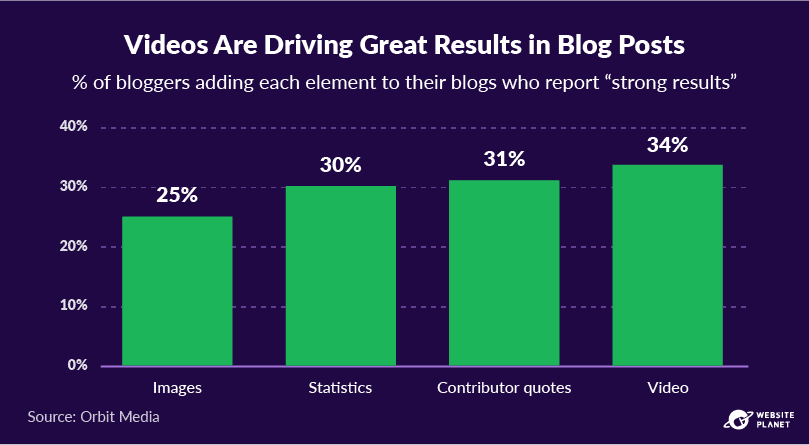 Video is the best-performing type of visual content. That’s because it’s naturally the most engaging form.
People typically prefer watching videos to reading text; video is stimulating and requires minimal effort to understand.
In one study, bloggers who used videos in their blog posts got the best results. Video content is 50 times more likely to receive traffic from search engines compared to plain text.
Video gets the best results out of all content types, yet just 25% of bloggers use it. It might be expensive and difficult to create, but if you can find some extra time, it’s worth placing within (or alongside) your blog posts.
Marketing efforts that use video are a great idea. If you can turn your blog post into a scripted accompanying video, even better!
Video is the best-performing type of visual content. That’s because it’s naturally the most engaging form.
People typically prefer watching videos to reading text; video is stimulating and requires minimal effort to understand.
In one study, bloggers who used videos in their blog posts got the best results. Video content is 50 times more likely to receive traffic from search engines compared to plain text.
Video gets the best results out of all content types, yet just 25% of bloggers use it. It might be expensive and difficult to create, but if you can find some extra time, it’s worth placing within (or alongside) your blog posts.
Marketing efforts that use video are a great idea. If you can turn your blog post into a scripted accompanying video, even better!
96. What About Audio?
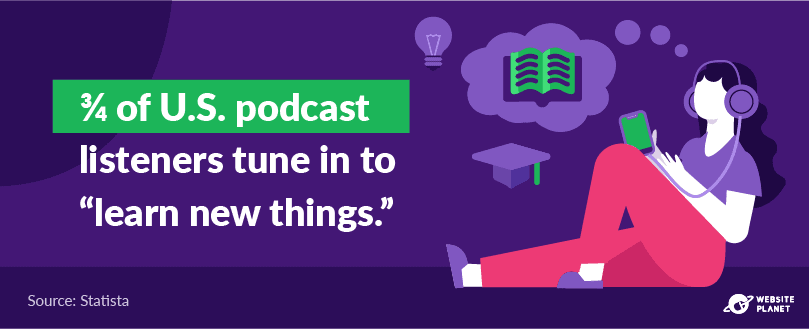 You should certainly add some audio elements to your blog post; audio provides another layer of engagement for your audience.
Audio gets results, too: 45% of marketers who use it in their blog content see improvements (OptinMonster).
It works so well because it offers a different sensory experience of your content. Not only that, audio versions of your content mean people can listen to it on the go. The more accessible your blog post, the bigger reach it will ultimately have.
Podcasts are in fashion right now. These should be the go-to audio type for any blogger because they are often informative; they serve the same purpose as your average blog post.
Podcasts also give you the chance to speak in more depth on a particular topic.
They’re the perfect accompaniment to a blog post. The proof is there for all to see — high-income bloggers are 5X more likely to have a podcast than low-income bloggers!
You should certainly add some audio elements to your blog post; audio provides another layer of engagement for your audience.
Audio gets results, too: 45% of marketers who use it in their blog content see improvements (OptinMonster).
It works so well because it offers a different sensory experience of your content. Not only that, audio versions of your content mean people can listen to it on the go. The more accessible your blog post, the bigger reach it will ultimately have.
Podcasts are in fashion right now. These should be the go-to audio type for any blogger because they are often informative; they serve the same purpose as your average blog post.
Podcasts also give you the chance to speak in more depth on a particular topic.
They’re the perfect accompaniment to a blog post. The proof is there for all to see — high-income bloggers are 5X more likely to have a podcast than low-income bloggers!
97. Finish With a CTA
 So, you’ve planned and written a fantastic blog piece with a great headline, engaging multimedia elements, and a ton of quality, original research. But there’s one more thing you need to add before the post is ready…
Placing a call-to-action at the end of your post will see huge results. This could mean diverting readers to another blog post, product, or offer on your site. Or, the CTA could simply remind readers to make use of all the useful information you’ve provided.
Either way, someone who makes it to the end of your blog post has probably found good value in your content. The reader will be receptive to whatever else your site has to offer. Adding a CTA can capitalize on this interest with massive results!
So, you’ve planned and written a fantastic blog piece with a great headline, engaging multimedia elements, and a ton of quality, original research. But there’s one more thing you need to add before the post is ready…
Placing a call-to-action at the end of your post will see huge results. This could mean diverting readers to another blog post, product, or offer on your site. Or, the CTA could simply remind readers to make use of all the useful information you’ve provided.
Either way, someone who makes it to the end of your blog post has probably found good value in your content. The reader will be receptive to whatever else your site has to offer. Adding a CTA can capitalize on this interest with massive results!










